|
Last week I was at my seventh Magento Imagine conference, and as I’ve done for the past six years, I’m doing a recap of my experience there, incuding what’s new, what’s the same, and what to expect for the year to come.
In a lot of ways, the Magento Imagine show is a summary of the past year, and a forecasting of the year to come.
Here’s what I took away:
- PWA is going to be a big deal. Progressive Web Apps (PWA) are a new Google standard that give a mobile visitor to your site extremely fast page load times, and a experience that is much more like an app (vs. a traditional site in a browser). PWA today is what responsive design was five or six years ago. Magento will be releasing a new PWA reference theme this year. I’ve covered PWA below in a lot more detail.
- Cloud is everywhere – hosting and trade show booth swag. Magento has made a big commitment to having their system hosted on the AWS cloud, that includes auto-scaling, caching, CDN and more. Nexcess has also released an auto-scale cloud hosting option as well, too.
- Five years ago, you could walk around the trade show and easily get USB thumb drives as booth giveaways.
- Now that files are stored and shared on the cloud, USB thumb drives are almost nowhere to be found. And even my later computer does’t have a standard USB A port anymore (although I have a ton of adaptors).
- Socks are the new, new booth giveaway. Something about spending twelve hours on your feet – socks are that new practical giveaway that everyone wants. I now have a nice new sock collection from Amazon, PayPal and New Relic.
- Speaking of Amazon, they’ve changed from being the 8,000 pound competitor in the marketplace that all eCommerce merchants are scared of, to being a company that gives a lot of proactive solutions, including Amazon Pay, AWS hosting, voice activated commerce with Alexa skills, and Amazon Marketplace integration.
- Stepping into the role of MC this year was Magento evangelist Philip Jackson, host of MageTalk. It was a different energy than Jamie from years past. But Philip I feel connected well with the community – because he’s such an integral part of it. He shared his inspirational story, bared quite a few vulnerabilities, and made us all feel part of the bigger Magento ecosystem.
- Jamie Foxx was an excellent speaker – especially since he has an eCommerce store using Magento Cloud to sell a new line of sunglasses. His real-life examples of A-B split testing also was pretty engaging.
- Magento founder Roy Rubin was spotted this year at Imagine (although not on the stage). And former Magento President Bob Schwartz was back again, too.
- Magento has been on a big hiring spree (they have more than 800 people now).
- Last year, I spoke at the conference (about how / why to integrate Magento stores with third party marketplaces, such as Amazon). My company had a diamond-level booth last year, too, and I brought a bunch of people out for the show. This year, it was just me – which meant I was a bit more free to wander around, meet people, and attend a lot of more of the sessions and tracks I found interesting.
- This year’s theme was "Lead The Charge," and the Magento team has been hiring and expanding in a lot of new directions to keep ahead of the technology curve.
Now… for the recap in photos:
First, a disclaimer. I didn’t attend all of the breakout sessions. I went to the ones that were most personally interesting to me. So my coverage is more curated and more selective.
As far as technical details go, I brought three cameras: a Canon 1DX Mark II, a Canon 5D Mark III, and my iPhone X. Most of the screenshots were taken with a wide angle lens, and then corrected via Lightroom. I took 6064 images, totaling 155 GB. I chose about 682 final images, many of which are featured in this recap.
A few photos on the #RoadToImagine:
I flew out early on Sunday morning, and got a window seat. After all, I love taking photos, so it’s nice to be able to capture the scenery from a plane.
Here’s a photo of Breckenridge, CO:

Here’s an image of Copper Mountain, CO. Both received a big dump of snow the previous week.

We also flew over Aspen, CO – here’s an arial view of the town:

Thanks to the folks at Nexcess for picking me up at the airport in a fabulous limo:
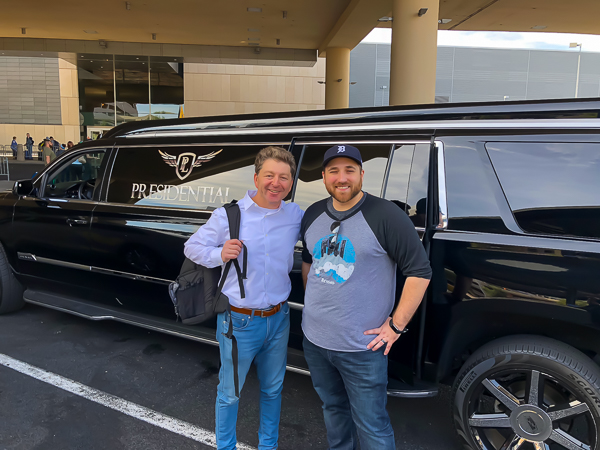
Sunday, I attended the partner meeting, and got a preview of some of the announcements that were going to be made at the show. In the past, the partner meeting was on Wednesday night, after everyone was exhausted from three days of the show – so it’s really nice to have it before when everyone can still form coherent sentences.
Opening Keynote:
I was first in line to get in the doors to the opening keynote this year, and there was quite a line of people waiting to get in.
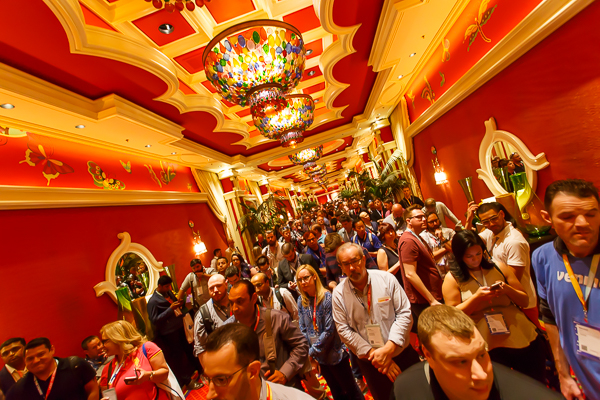
The keynote was split between the theater (which is about a 15 minute walk from the main exhibit area.
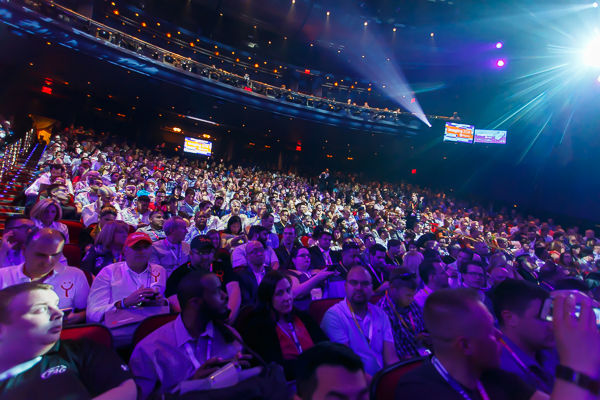
I took a selfie with a (new) friend who is a system integrator from London.
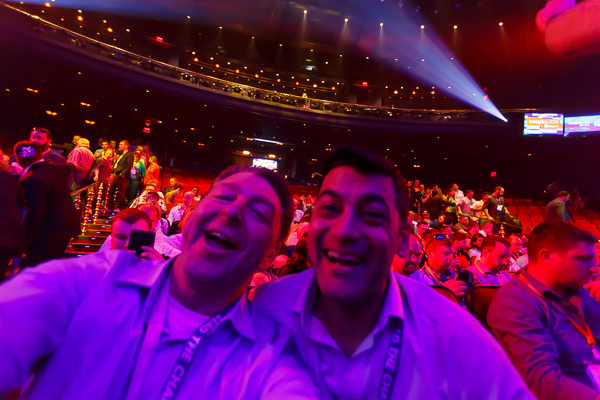
New this year… the presentation screen was made up of five giant LED panels that hung from the ceiling:

The four main panels split up and came together in fun ways:
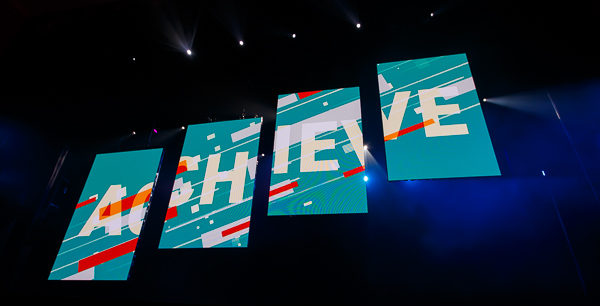
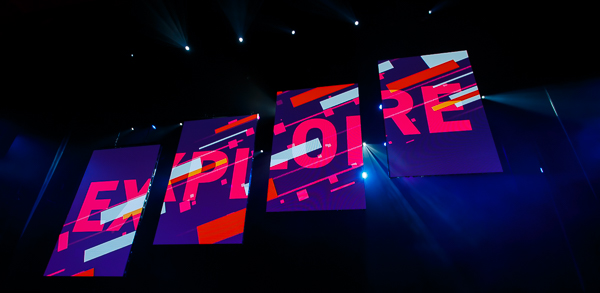
And then snapped back together for the main theme of the conference:
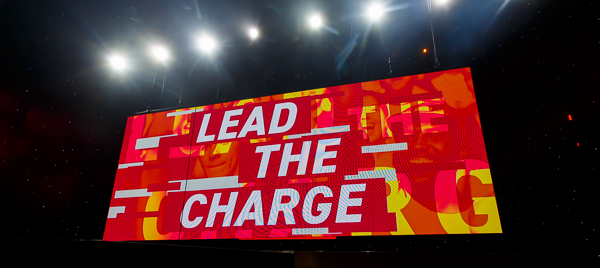
This year, Phillip Jackson replaced Jamie as the MC for the keynote presentations. All in all, it was a good change. Phillip Jackson is a Magento Master and the producer of the MageTalk Podcast show that has 100,000 listeners each month.
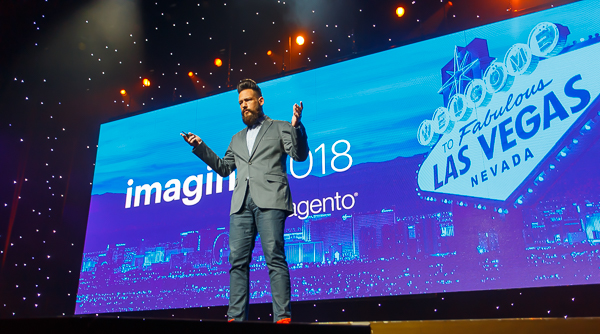
In many ways, he’s a voice that a lot of us in the Magento ecosystem have known for a while.
There were a lot less mountaineering examples and stories of getting lost on the side of the mountains, but more stories of the inward struggle of what it means to be a good developer in this space.
After a brief video where Jackson gave guidance on coding:
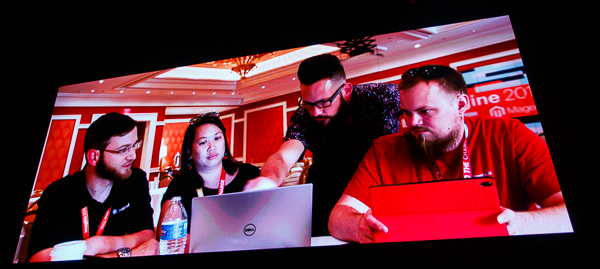
… and handed out Magento propaganda on the strip of Las Vegas:
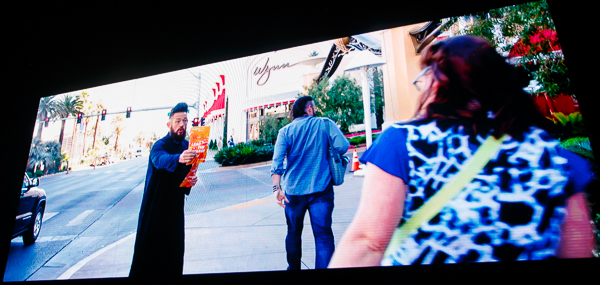
… Jackson rose out of the stage in legendary style:
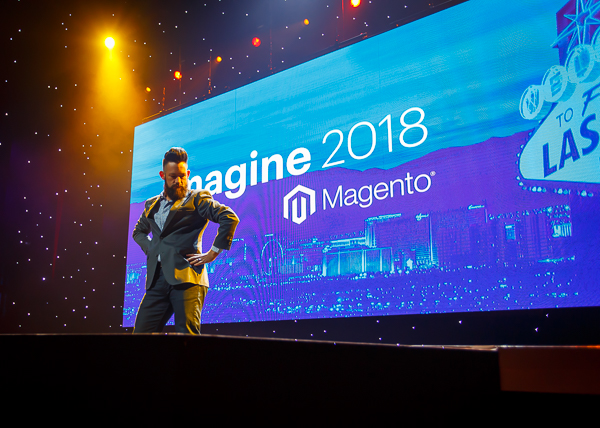
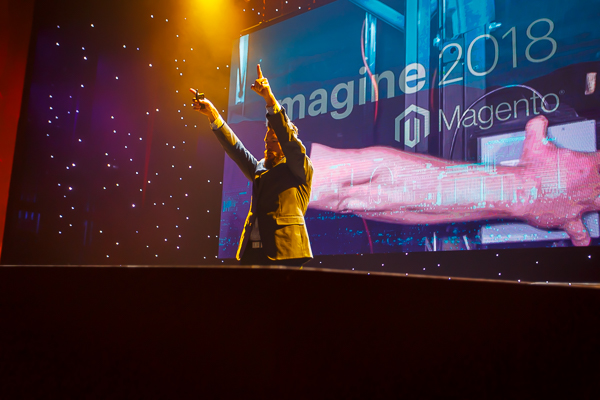
You might have seen his Mage Name site in the past, where you can create Mage-branded themes auto-magically:
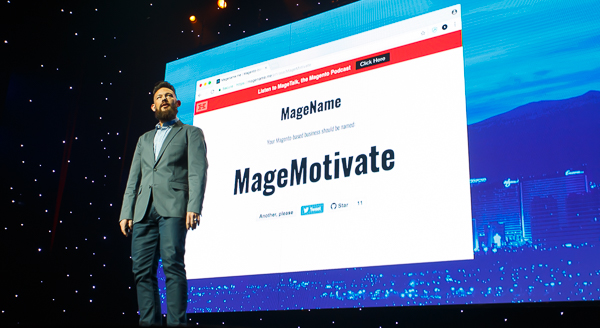
He talked about his #RoadtoImagine, and how he came to be standing on the stage:
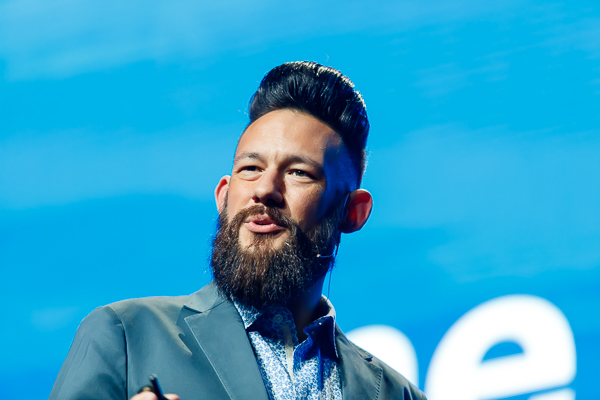
Jackson became Magento certified in 2011; attended his first Imagine in 2013; raced cars and learned a crane kick (used on past MC Jamie in a video); became a Magento Master in 2016 (you get a great sweatshirt); and had a podcast booth at the show last year:
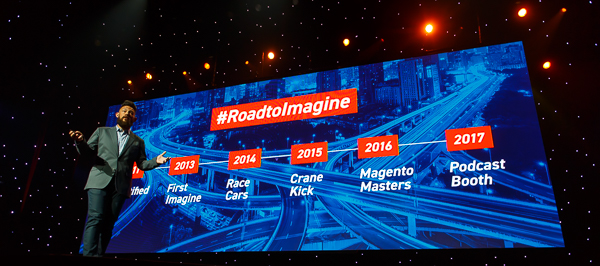
Jackson then introduced Magento CEO Mark Lavelle to the stage:
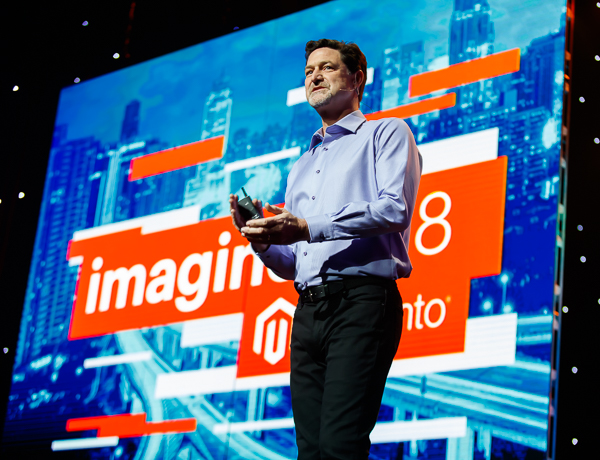
Lavelle discussed Magento’s new mission / values statement:
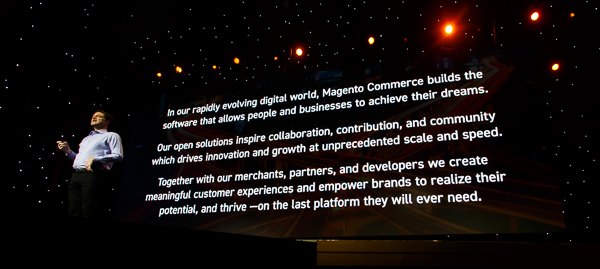
"In our rapidly evolving digital world, Magento Commerce builds the software that allows people and businesses to achieve their dreams."
"Our open solutions inspire collaboration, contribution, and community which drives innovation and growth at unprecedented scale and speed."
"Together with our merchants, partners, and developers we create meaningful customer experiences and empower brands to realize their potential, and thrive – on the last platform they will ever need."
Lavelle laid out goals for the community:
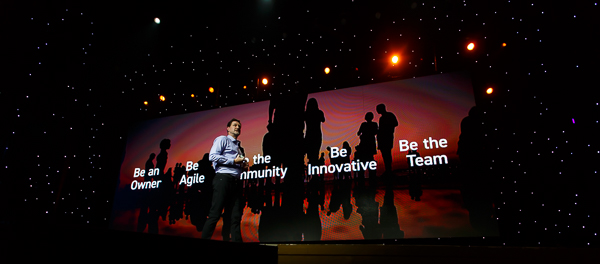
- Be an Owner
- Be Agile
- Be the Community
- Be Innovative
- Be the Team
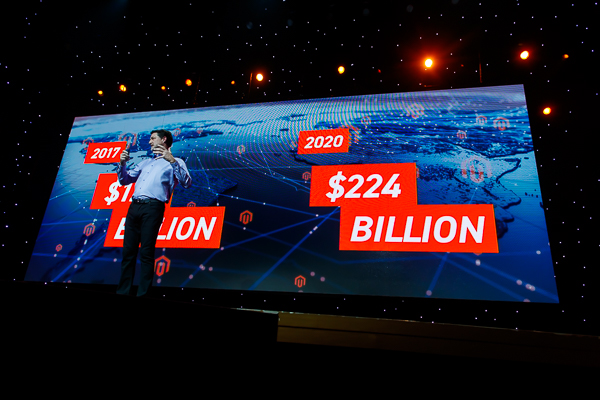
More quick Magento stats:
- eCommerce Merchants on the Magento platform are growing 80% faster than people on other platforms.
- In 2017, Magento sites did more than $124 billion in transactional revenue.
- By 2020, that’s expected to grow to $224 billion.
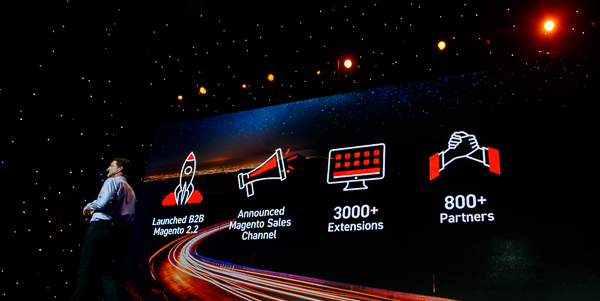
This year, Magento has:
- Launched the B2B Magento 2.2 module
- Announced Magento Sales Channel (Magento to Amazon direct integration)
- There are now more than 3,000+ extensions in the Magento marketplace (which have been tested for compatibility and functionality).
- There are 800+ partners in the Magento ecosystem.
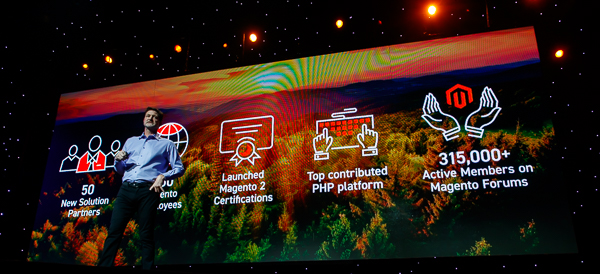
In addition, there are now:
- 50 new solution partners across the world
- Magento has 800 employees worldwide
- Magento 2 certifications have just launched
- Magento is the top contributed PHP platform
- There are 315,000+ active members on the Magento forums
What this means is that there is a vibrant ecosystem of companies, developer and merchants that are all contributing to the success of the platform. (And this is very unique in the software world.)
Huge brands, like Coca Cola, Warner Music, Universal Music, Rosetta Stone and many more are using Magento’s platform:
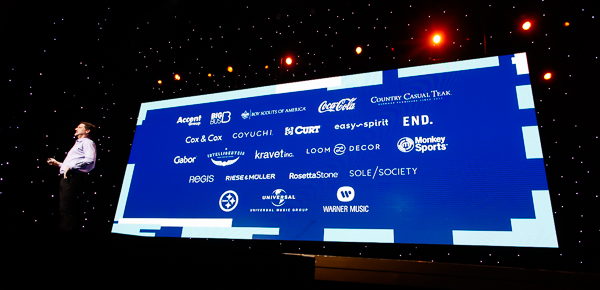
Jackson then pseudo-interrupted by riding an electric bike onto the stage, tricked out in Magento orange with #RoadToImagine and the Magento logo on it:
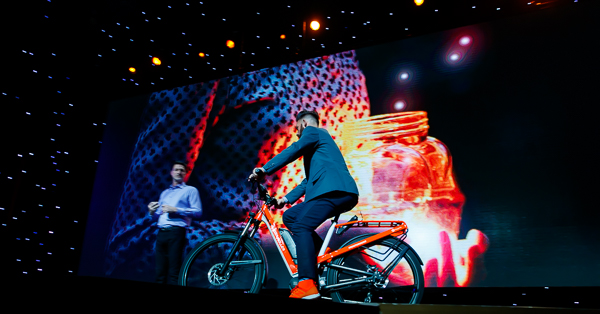
The electric bike was part of an auction to raise money for the Make a Wish Foundation:
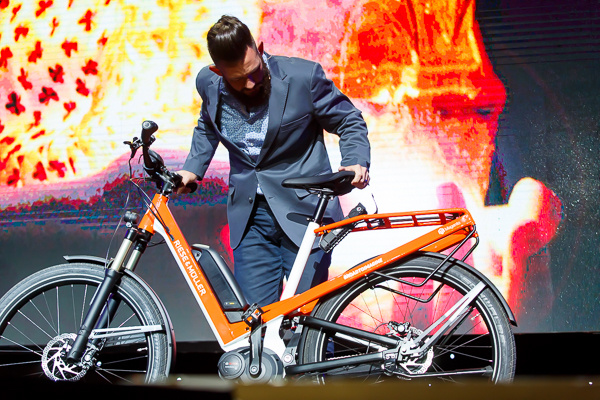
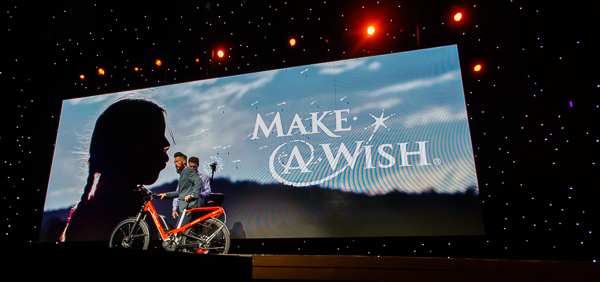
Speaking of helping out the world, Magento Chief Marketing Officer, Andrea Ward introduced the First Book organization that gives away free books to underprivileged kids, and uses the Magento platform to support spreading literacy.
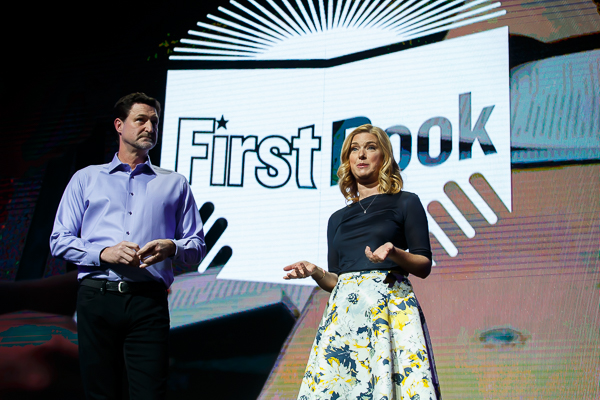
Magento made a $10,000 donation to the First Book organization:
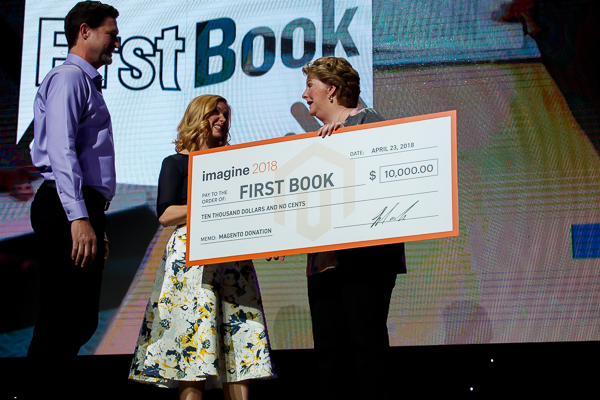
Lavelle then welcomed Peter Sinclair, SVP Consumer of Universal Music Group to the stage:
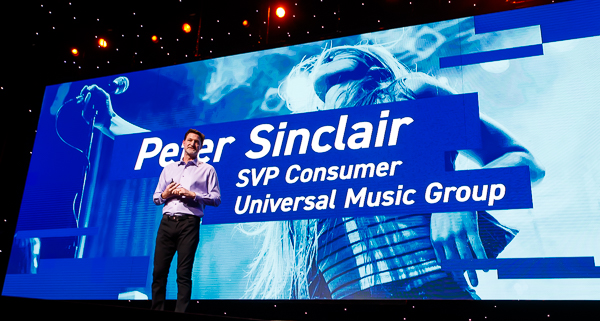
Sinclair took out his phone and took a few photos of the audience for his daughter:
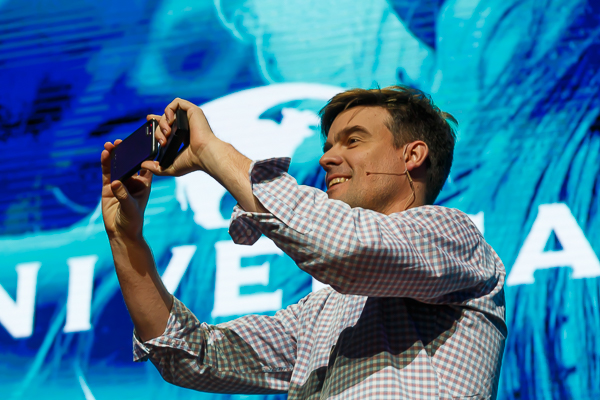
Sinclair talked about his role in building an eCommerce and Superfan Business in the New Music industry:
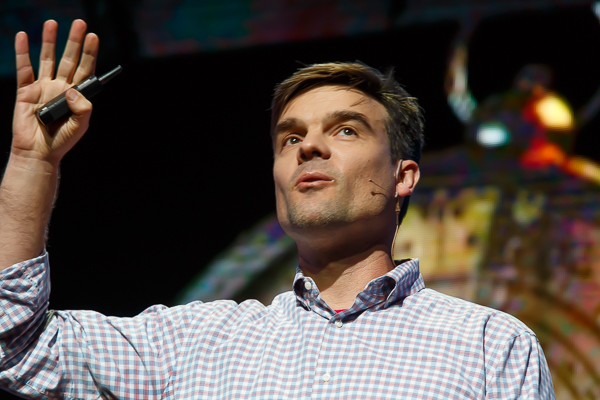
Universal music represents about 40% of the world’s recorded music (I added the apostrophe), among a number of brands:
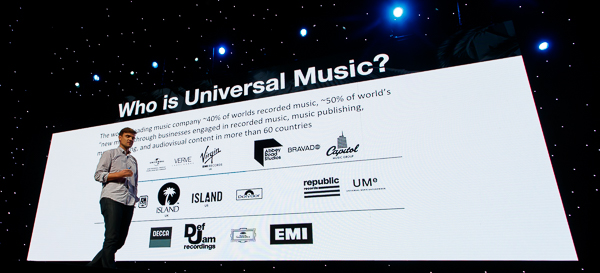
Sinclair’s mission was to turn a 7 figure business into a 9 figure business, by engaging with superfans. Superfans are the highly-engaged music fans that love a particular brand, and want more than just to listen to a standard track of music.
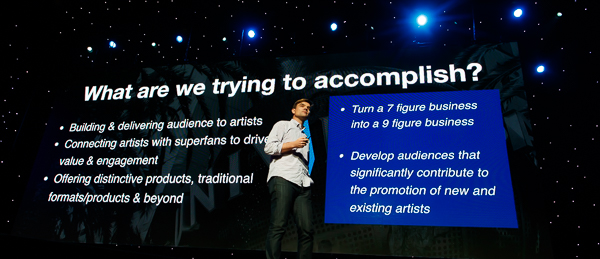
Sinclair said that he tried to apply past methods to the approach, by offering compelling products to fans, testing, measuring and repeating:
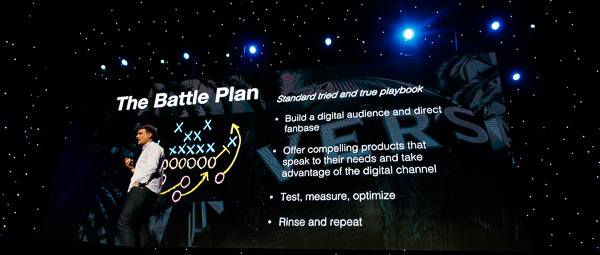
The reality? It was a lot tougher to accomplish:
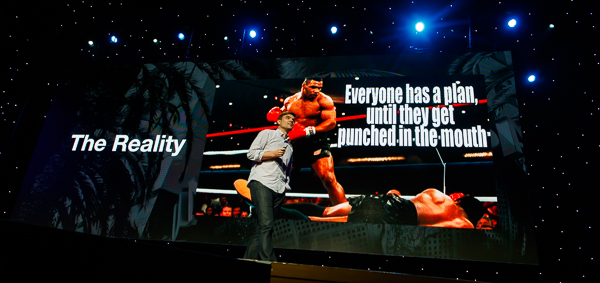
Sinclair said that music is really hard, because it’s highly fragmented, and the consumer of music is not at the center.
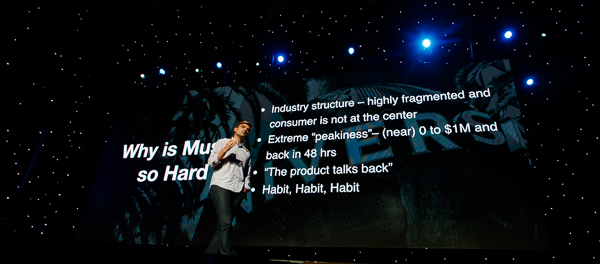
Music has extreme "Peakiness", meaning it can go from near $0 to $1 million in revenue in just 48 hours. And there’s a lot of ingrained habits from the past.
What they’ve been able to achieve with Magento, however, is huge growth – 3.6 times in three years, with 2018 up 120% year over year:
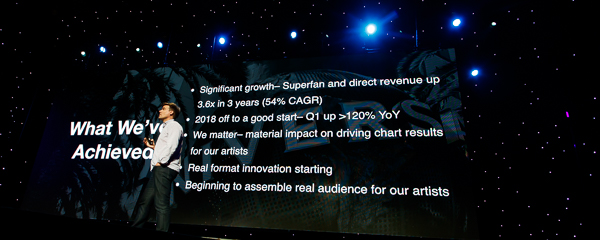
They focused on the ability to quickly spin up new fan sites in minutes, and add in new merchandise and other content that would appeal to the super fans.
Up Next: Mark Lavelle introduced Bill Scott, VP of PayPal Consumer & Venmo Engineering to the stage.
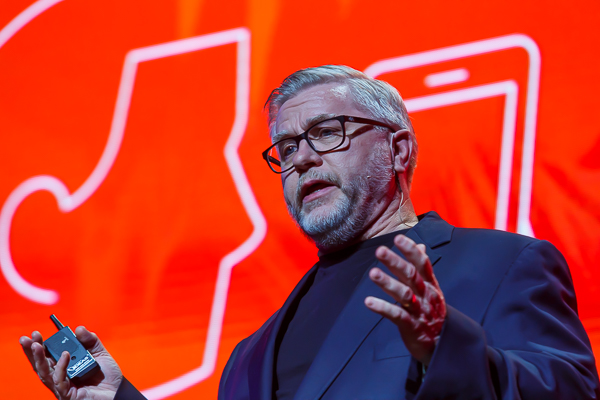
Scott talked about how in commerce, money is about transactions:
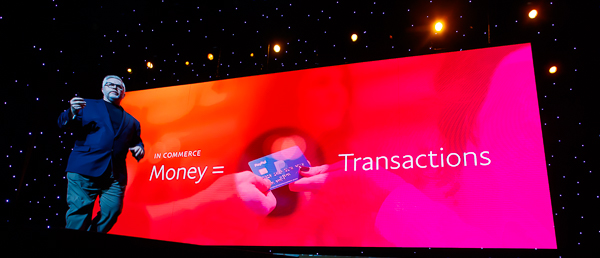
But for consumers, money is about experiences.
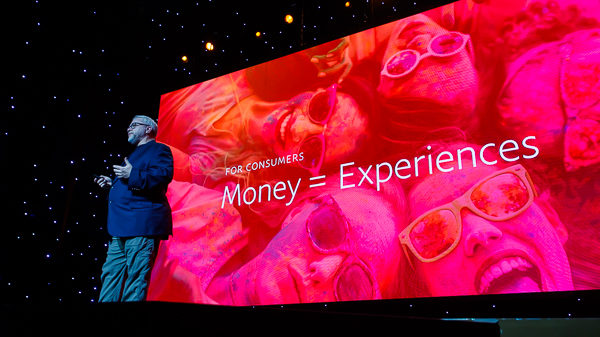
Scott talked about moving to New York for a year to lead the Venmo engineering team. He was amazed – when he told the person helping him find an apartment what he did, she gave him a hug, and let him know how important Venmo was in her life.
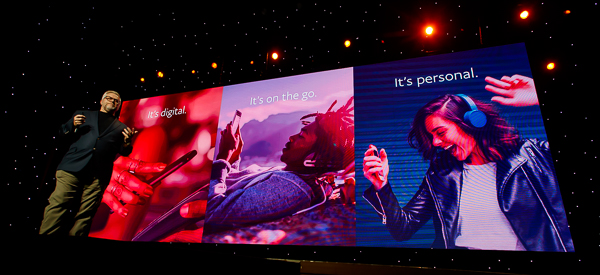
For those of us non-millennials, Venmo is a person-to-person payment system that allows people to send their friends money. To split a bill at a restaurant or pay rent… but the experience is social.
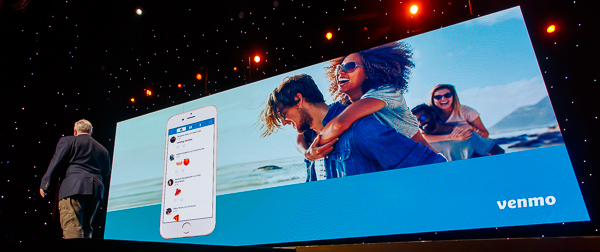
Over 80 million consumers have an active PayPal account, and PayPal is accepted by more than 8 million merchants.
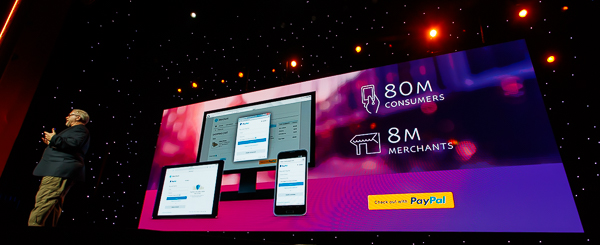
81% of Venmo’s users are millennials:
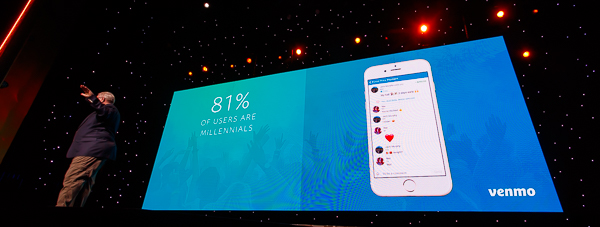
For them, money is a story. When a payment is made, it’s shared socially on a feed.
Scott talked about how he uses Venmo to connect with his daughter. He sends her $5 each morning so she can go get a coffee – even though she lives on the other side of the United States.
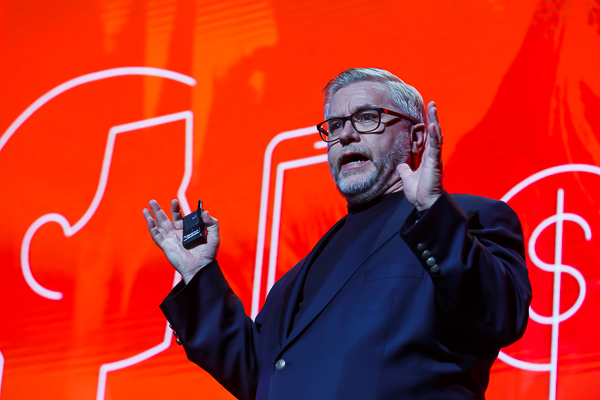
Next up: Sucharita Kodali, VP of Forrester Research, who shared a bit about the competitive landscape in the eCommerce world:
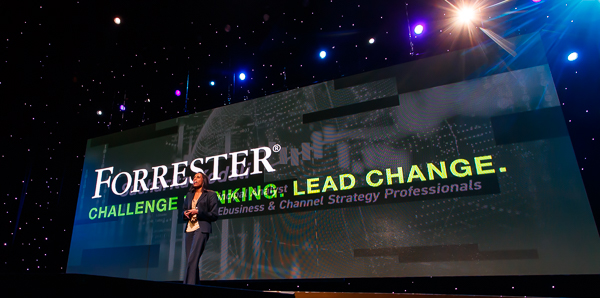
Although some retail stores are having challenges, such as Toys R Us:
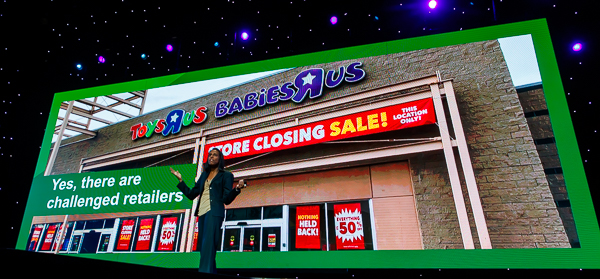
… there isn’t actually a retail apocalypse:
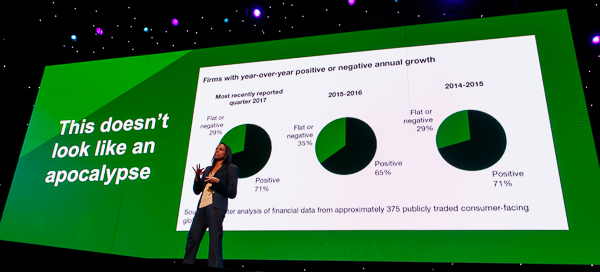
Instead, 71% of 375 publicly traded consumer facing retailers are seeing year-over-year positive growth.
The ones that are less successful are due to:
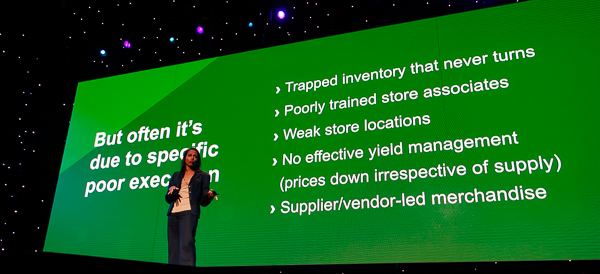
- Trapped inventory that never turns
- Poorly trained store staff
- Weak store locations
- Pricing that doesn’t take into account supply
- Supplier or vendor-led merchandise
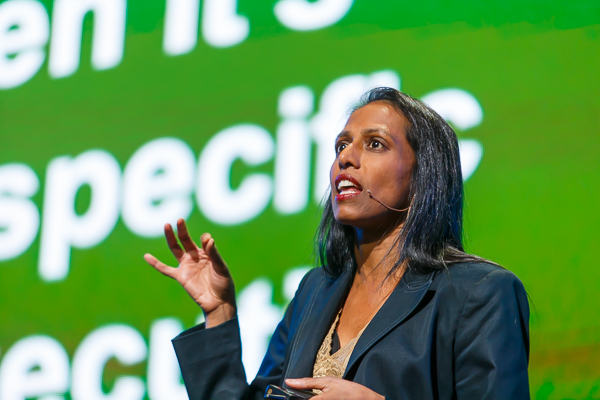
According to Kodali, the successful merchants these days are slaying orthodoxy:
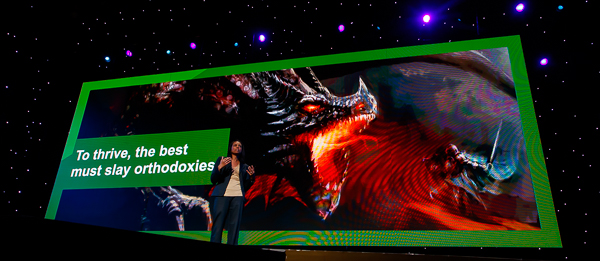
… including cost plus pricing, overseas manufacturing, seasonal merchandise and more:
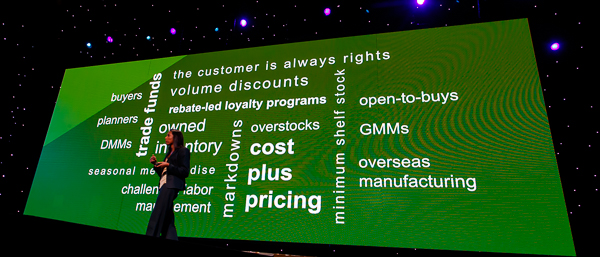
She went on to explain that during last year’s total eclipse, the older ways of selling eclipse glasses no longer worked. Everyone was sold out.
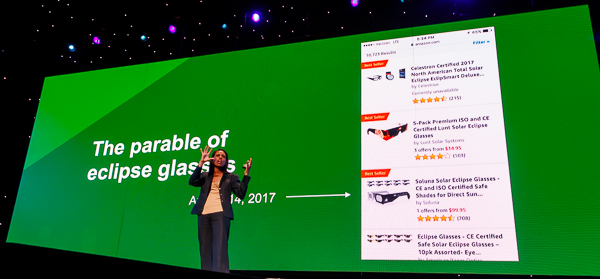
But she was able to find them on Amazon, through the third party marketplace sellers.
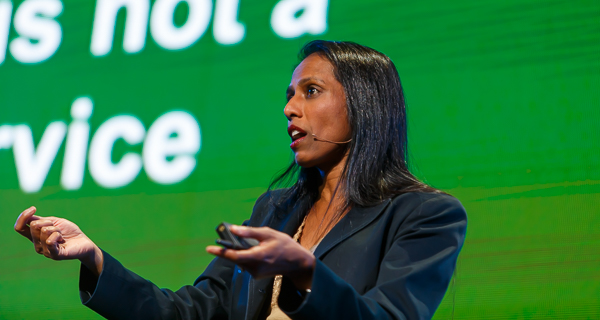
The eclipse was a well documented event – but most retailers did not plan ahead for it, and lost a significant amount of sales as a result. (Kodali wound up paying $10 per pair, instead of the $1 – $2 rate).
According to Kodali, third party marketplaces are a great way for products to be matched to buyers. Apparently, the most popular category for Best Buy Canada is the baby and maternity section – not a traditional segment for Best Buy, that usually deals with consumer electronics.
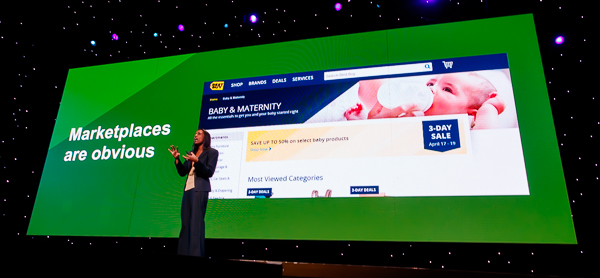
A second trend – On-demand manufacturing – promised to become more mainstream. Instead of carrying expensive inventory, products like fidget spinners can be 3D printed when someone places an order.
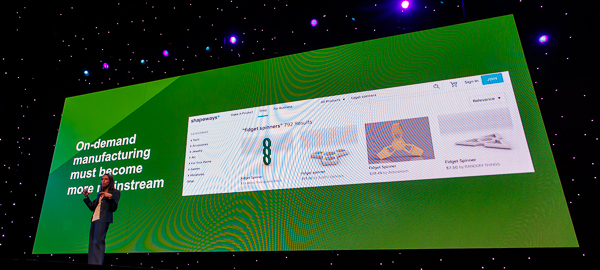
A third trend – demand is not always so easy to predict. For example, even though you can purchase AA batteries much cheaper on Amazon through their Amazon Basics brand, most consumers still prefer to purchase batteries at retail (probably because a device needs batteries right away).

Faced with smaller demand, Energizer and others were able to raise their prices by 8% and increase their margins... making more money by selling less, due to customers not minding that they are paying slightly more for the convenience of purchasing at retail.
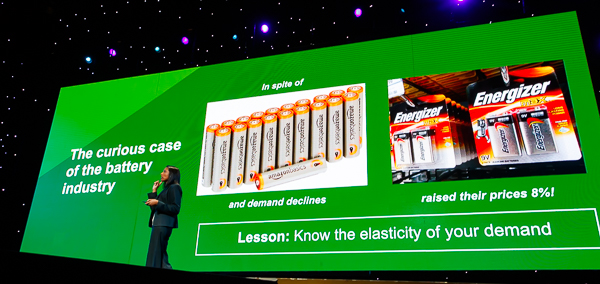
A fourth trend – scaling service:
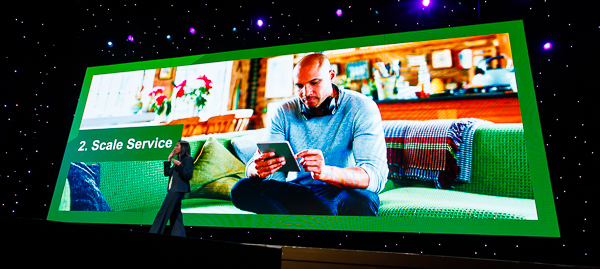
Tough to do, without having to hire a lot more people. Online chat – which many millennials like to use, allows an eCommerce store to be able to have one person handle 3-4 chat sessions at the same time. (As opposed to phone support, where support doesn’t scale as easily.)
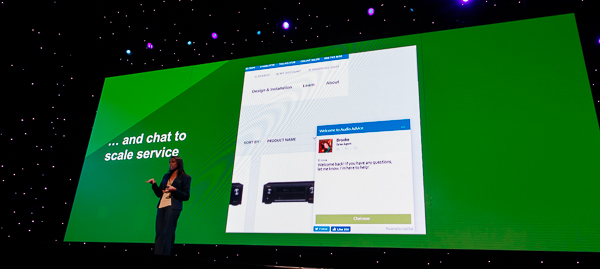
Kodali found that restaurants have done this really well, with order ahead or paying a check at a restaurant. (If you’re like me, time seems to slowwwww downnnnnnn as soon as I ask a server for the check.)
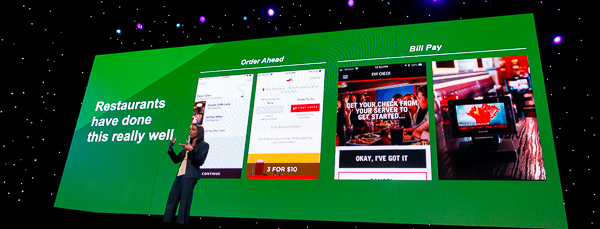
A fifth trend – AI powered solutions. Because no presentation is allowed today that doesn’t discuss machine learning. Companies like TFI Fridays are using AI to power a new mixologist, that will develop drinks based on your mood and what ingredients you like. (No word if it actually tastes very good, though.)
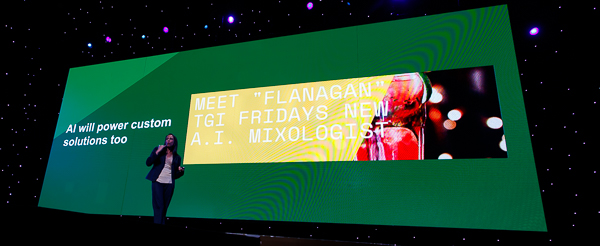
Kodali talked about how businesses are increasingly embracing new business models to stay relevant:
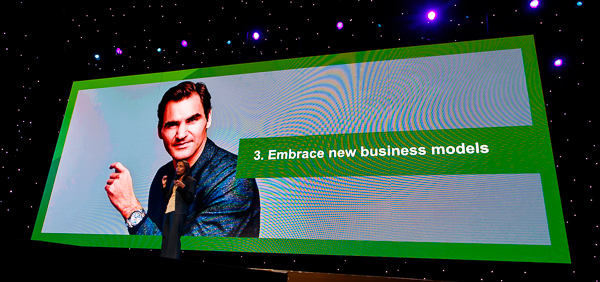
According to Kodali, the "Text Titans" have all changed their businesses:
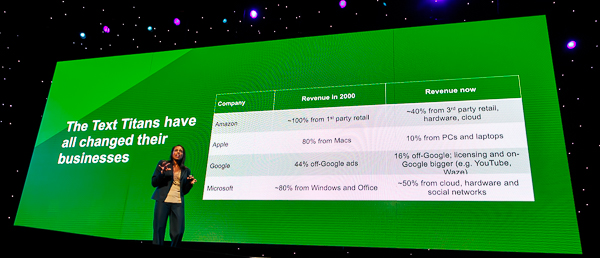
- Amazon moved from 100% sales from 1st party retail in 200, to now making 40% of their revenue from 3rd party marketplaces, and cloud hosting.
- Apple in 2000 made 80% of their revenue from Macs, but now only 10% of their revenue comes from laptops and desktop computers.
- Google in 2000 made 44% of their revenue from advertising. Now, a lot more is coming from YouTube, Waze, licensing and more
- Microsoft in 2000 took in 80% of their revenue from Windows and Office sales. Now 50% of their revenue comes from cloud, hardware and social networks.
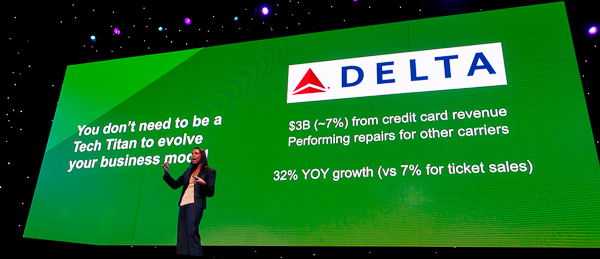
Delta Airlines makes 7% of their revenue from branded credit cards (the ones that get you free perks like a drink and a "free" checked bag). And they’ve also expanded by performing airplane repairs for other carriers – and better utilizing idle mechanics that sometimes had to sit around, waiting for problems to occur.
The movie theater industry has grown on-screen advertising to $800 million dollars in 2017, for example:
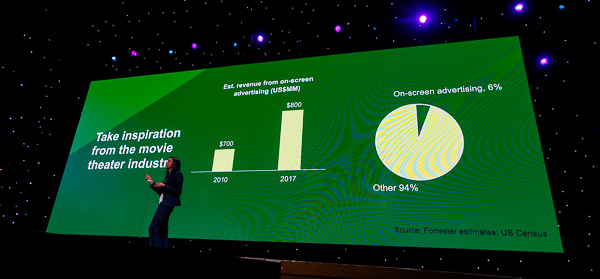
The other big reminder with retailers – some have tremendous reach:
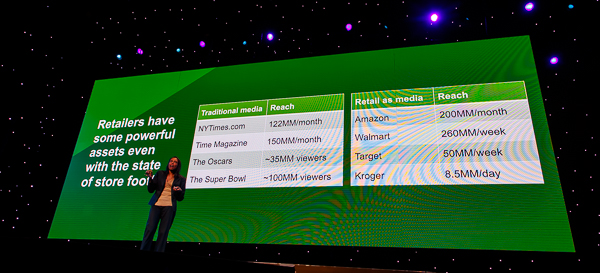
While the Super Bowl attracts about 100 million viewers each year, Walmart reaches 260 million consumers each week. The Oscars reach about 35 million views each year, but 50 million people shop at Target each week.
Kodali expects to see more retailers trying to capitalize on their reach in new and innovative ways.
Successful businesses are working with "spotters" to find the next great ideas in the marketplace. Sites include CircleUp and The Grommet that target early adopters.
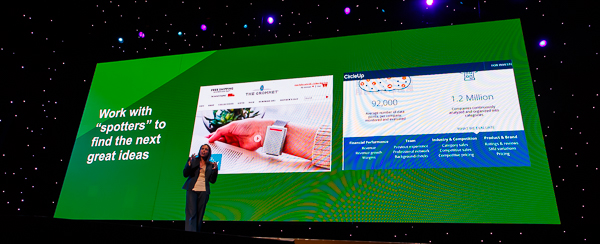
Summing it up, Kodali said that businesses should "Lead the Charge" (Magento Imagine’s 2018 theme / slogan) by:
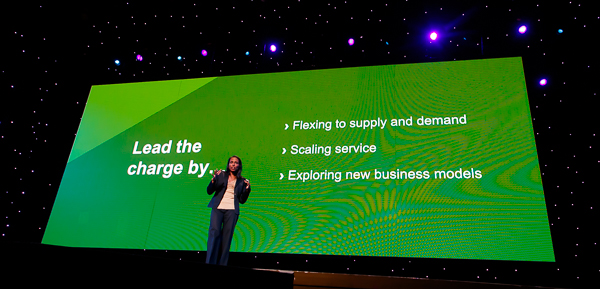
- Flexing to supply and demand
- Scaling service
- Exploring new business models

Phillip Jackson then ended the first keynote by telling an inspirational story of how he battled adversity, lost over 125 pounds and took his life back. He started running and eating well, and is a lot healthier. Jackson bared his vulnerability, and this honesty about how life can be a struggle resonated with the audience.
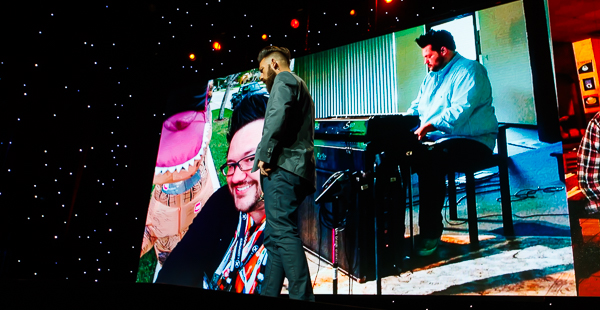
All too often at conferences like Imagine, the content is filled with people who love to talk about how they are extremely successful, and have no problems or obstacles to overcome. Or the ones that they do are just silly – like how do we spend all of our money?
It’s refreshing to hear from someone in the Magento community like this. It resonated with me, too. I’ve also had some challenges since the last Imagine 2017 show, but I started running and lost 35 pounds and 1/2 a foot from my waistline. Last April 17th, I started running, and haven’t stopped moving ever since:
I did bring my running gear to Imagine… I do love waking up early and doing a run up and down the strip. It’s always fun to see people stumbling home at 6:30 am, wearing rumpled suits and party dresses from the night before.
Here’s a couple of my routes (thanks to my Apple Watch and iPhone for helping me track my fitness):
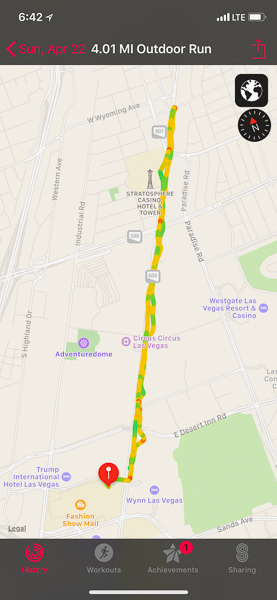
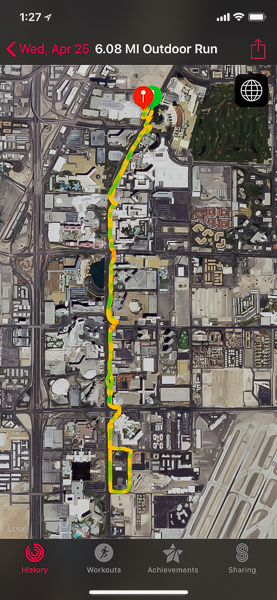
Here’s a couple of photos (taken on the iPhone X) of Las Vegas: (Sometimes more inspirational than sitting in windowless, dark conference rooms for hours on end.)
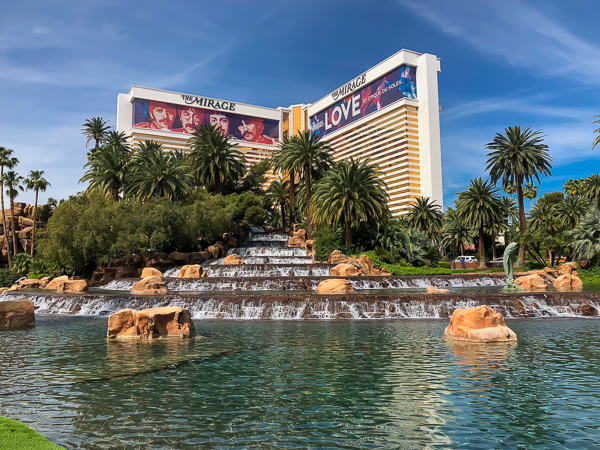

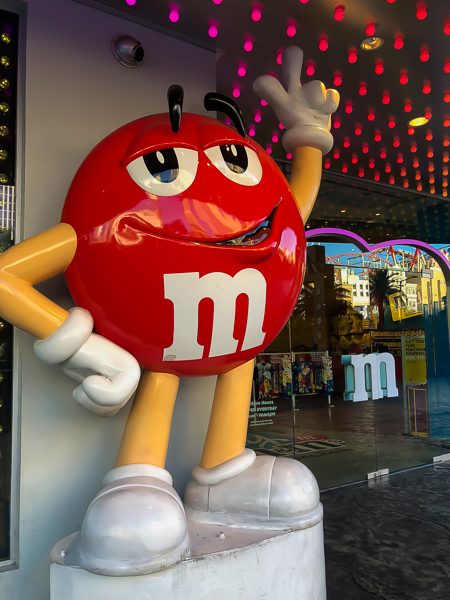

After the keynote, I wandered through the vendor marketplace, and ran into a few folks, including Tim England of Magento:

Selfie, using my 17 mm wide-range lens:
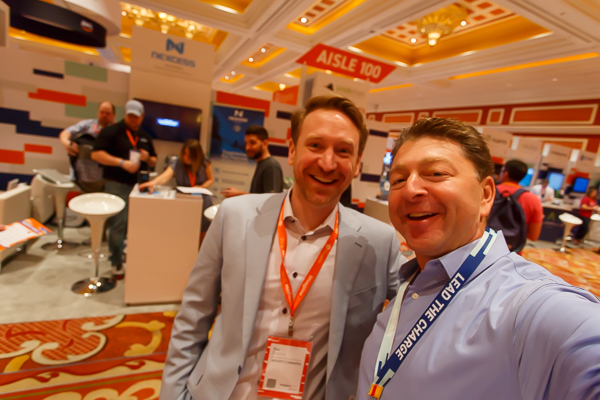
The Magento booth:
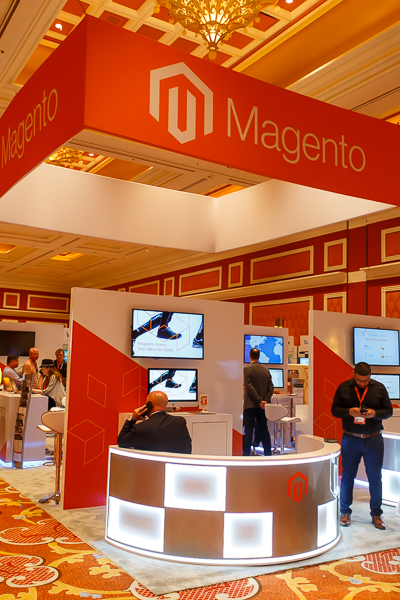
PayPal booth:
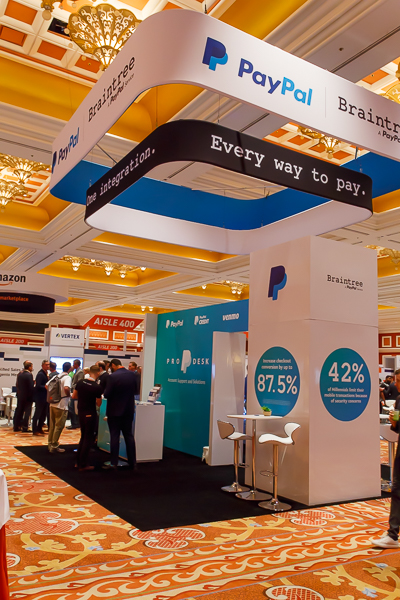
There was a color-in mural in the room:
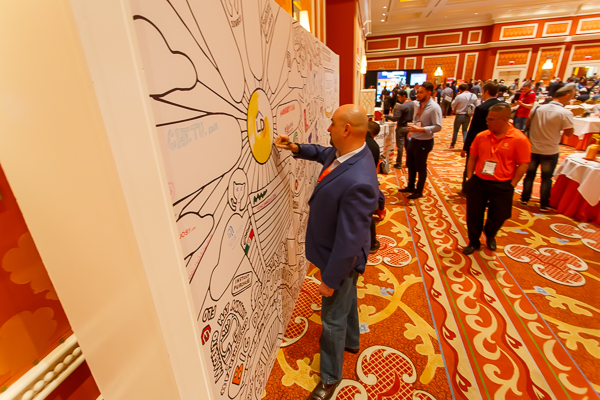
A couple of people from PayPal:

And a sighting of Bob Schwartz, former President of Magento, from way back in the day:
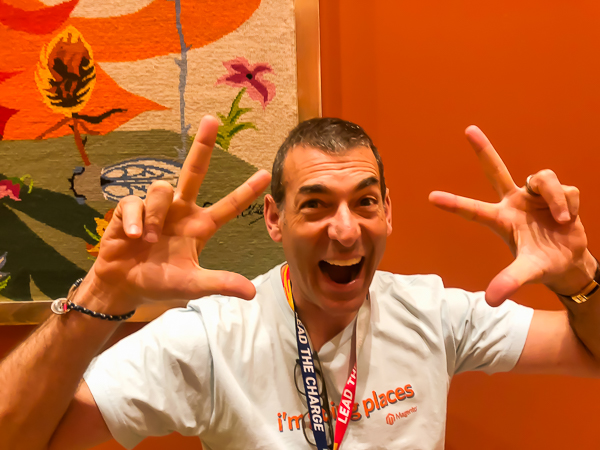
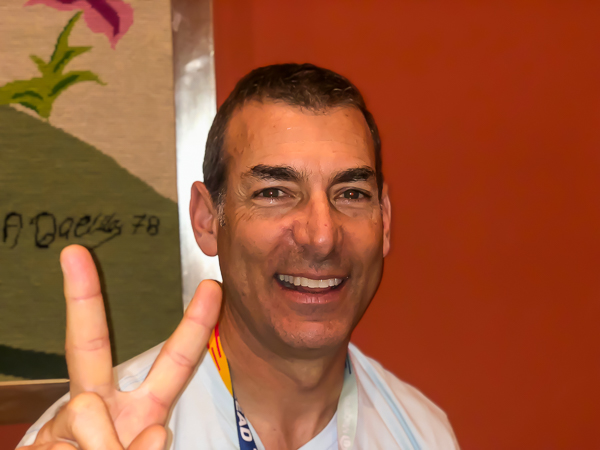
Before the keynote, I popped into a session, "Going beyond the AI Hype."
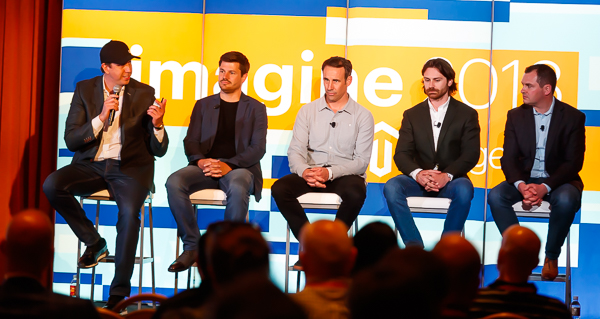
The session was led by:
- Allen Nancem, CMO of Emarsys
- Jason Fordham, VP of Product at Emarsys
- Peter Sheldon, VP of Strategy at Magento
- Myles Shipman, VP Business Development at Born
- Ryan Green, Director of e-Commerce at TravisMathew
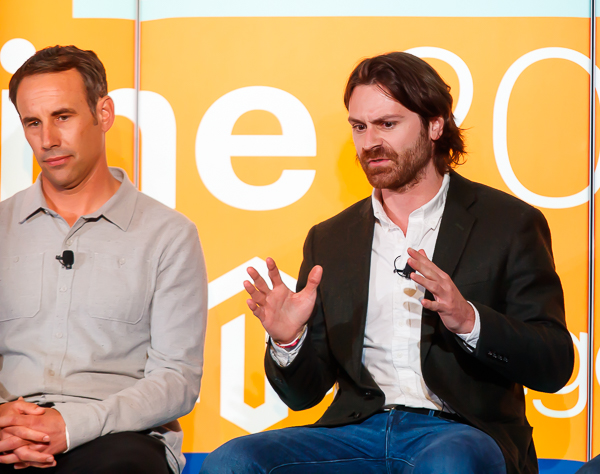
Peter Sheldon spoke about things in the marketplace that claim to be AI (Artificial Intelligence) but are really just sophisticated algorithms. In order for it to be AI, some level of machine learning needs to actually take place.
The panel talked about the myth vs. reality of AI, and talked about how even smaller companies can leverage some of the new machine learning tools and systems in the marketplace.
Monday night, I was whisked away by another VIP Nexcess limo, and went to a driving range not far from the strip.

Great food, great drinks and fun to hang out with other people in the Magento ecosystem (and get out of the Wynn for a few minutes).
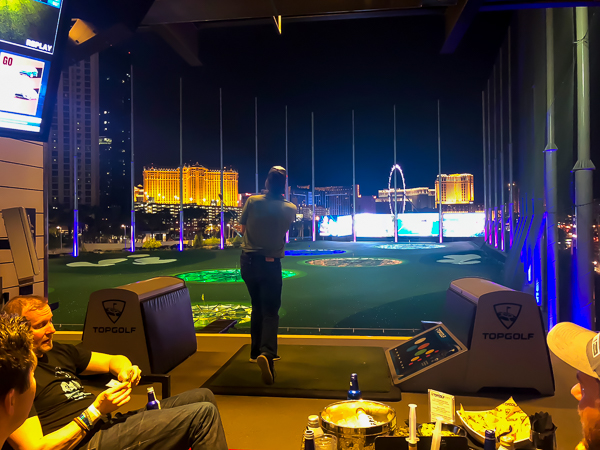
I’m not a huge golfer, but I was amazed by the technology inside the golf balls. Each golf ball has a chip, so that when you hit it, the system tracks in near-real time how far you hit the ball, where it went, and gives you a score.
Imagine 2018 – Day Two:
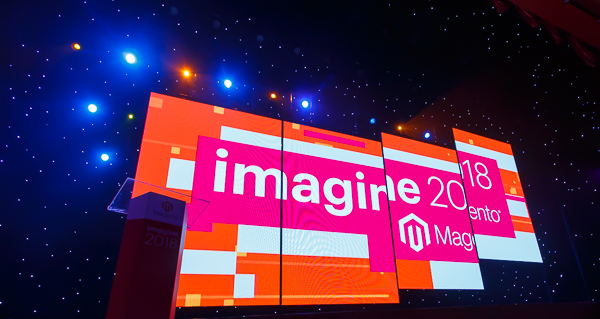
I woke up pretty early on the second day of the show (third day for me, since I got there on Sunday for the partner summit) and went for a run on the strip.

Jumping into the keynote, Phillip Jackson introduced Magento CEO Mark Lavelle, who then brought out a couple of people from the Pittsburgh Steelers.
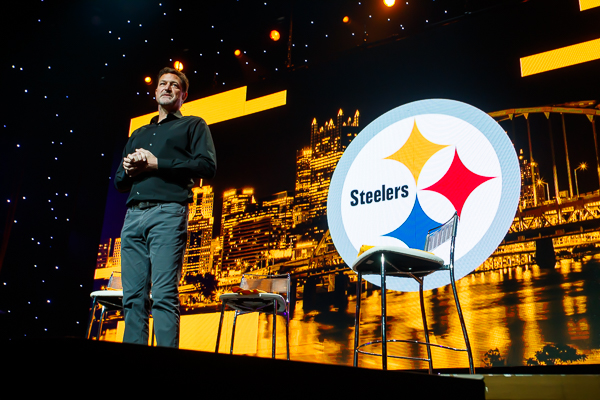
The Steelers use the Magento platform to connect with fans around the globe, and Lavelle has been a Steelers fan for years and years.
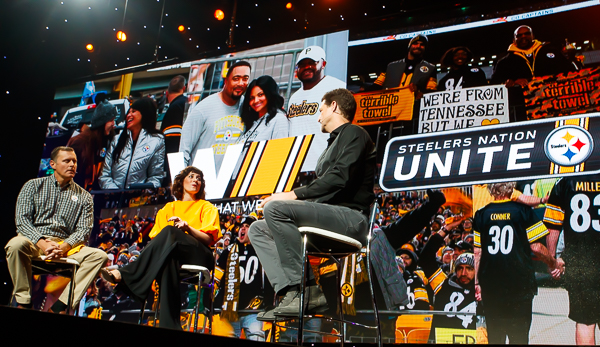
The Steelers use Magento to quickly push out product and merchandise ("merchandise" as they talked about it) to their superfans.
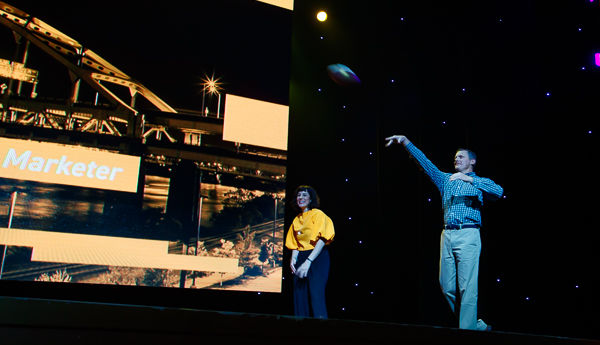
And they threw out a few fan towels into the audience.
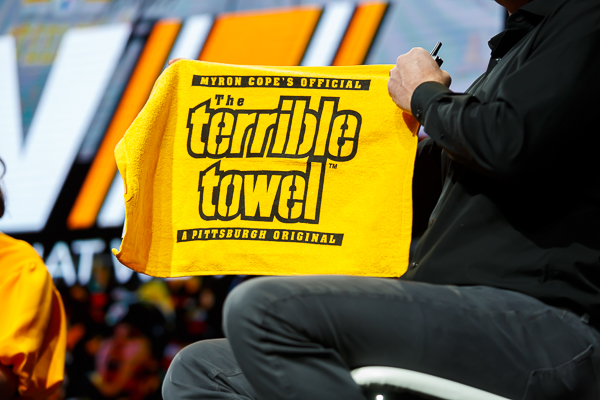
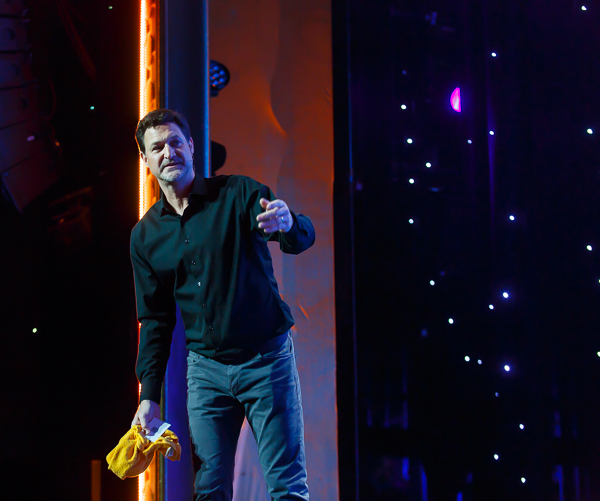
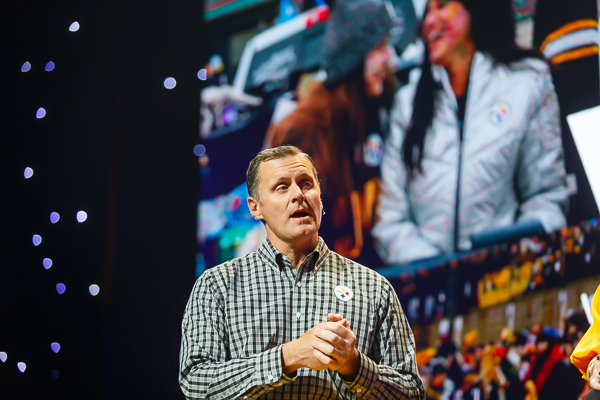

Next up: Melissa Ben-Ishaya, founder of "Baked by Melissa"
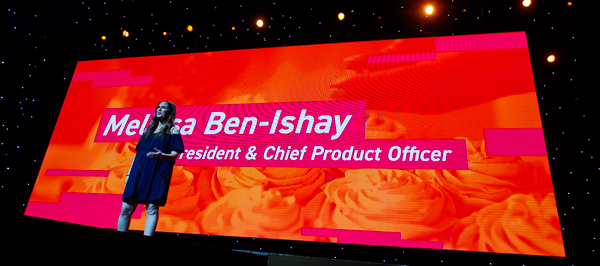

Ben-Ishaya talked about how she loved to bake cupcakes…

And when she was laid off from a job in New York her brother and his business partner encouraged her to bake some cupcakes. They built a basic eCommerce Magento site, and created a logo quickly for her.
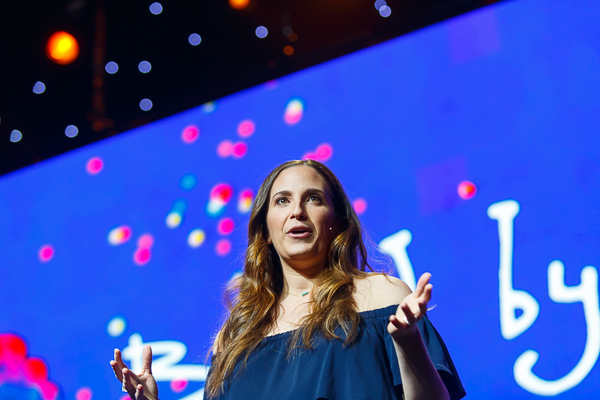
One thing led to another, and Ben-Ishaya’s cupcakes made it in front of some of the top party and event planners in New York.
Her unicorn cupcake was a big seller, and now they have retail stores and a great online business.

Next up: Magento Masters, who spend all their free time (and some work time, too) contributing to, and evangelizing for, the Magento platform.
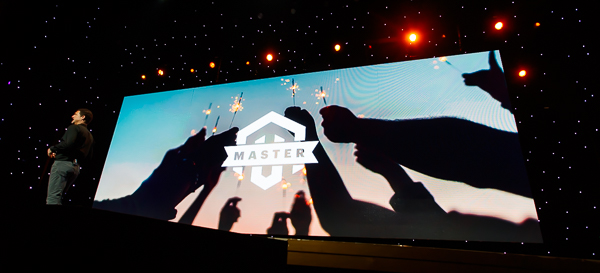
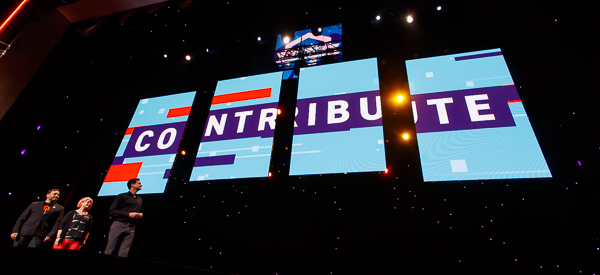
Ben Marks and Sherrie Rohde presented this year’s Magento masters:
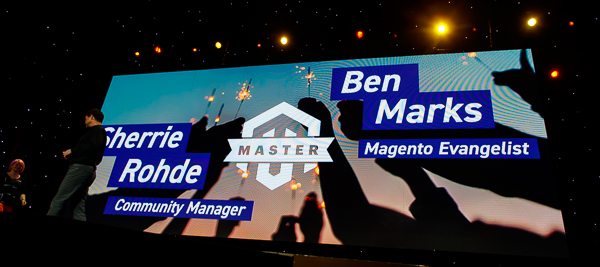
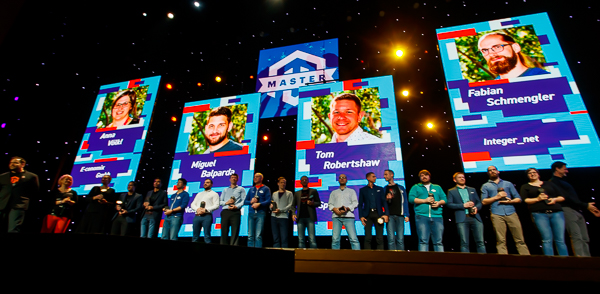
Mark Lavelle next introduced the Magento Innovations Lab.
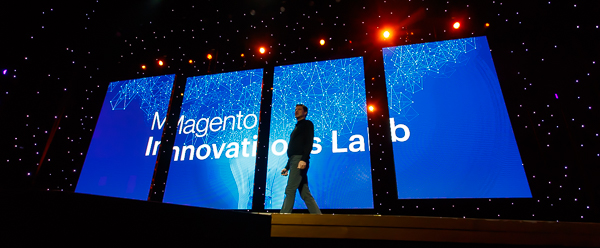
This is where Magento is highlighting some of the fun and inspirational contributions from the community.
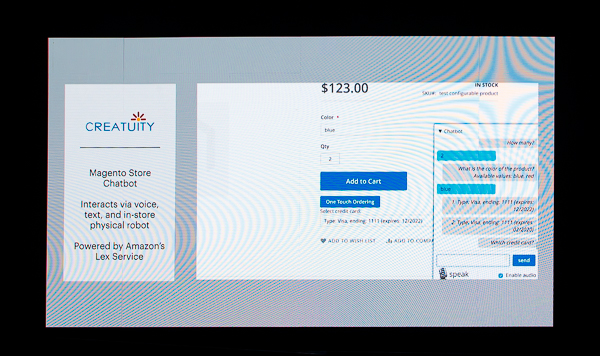
For example, hours after Amazon’s "1 Click Purchase" patent expired, community collaborators created an extension that allows any Magento merchant to offer this same functionality. The system used the core Braintree payment method that allows for payment information to be securely stored within Braintree’s vault.
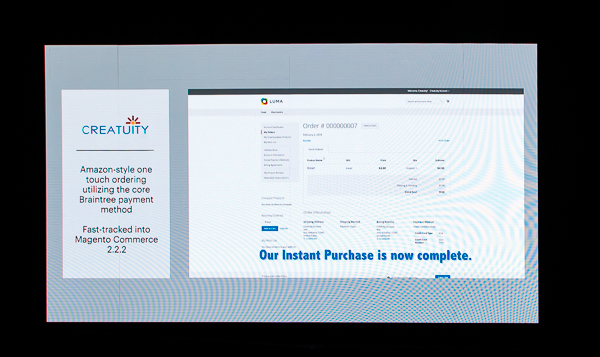
Another company added in a Google chatbot system create a seamless shipping experience with voice-activated virtual assistance:
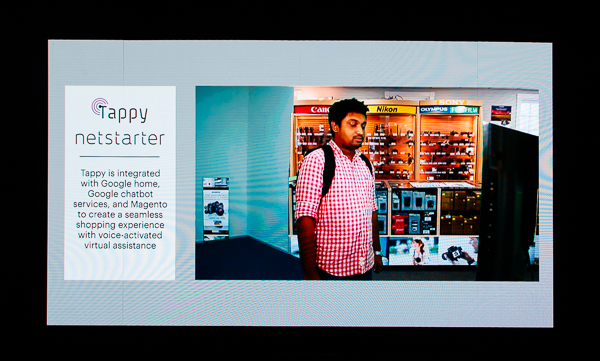
Another company created a complex pricing engine that generates tier-based prices based on the cost of the source materials – in this case for building and designing cables (such as fiber, video, ethernet or audio):
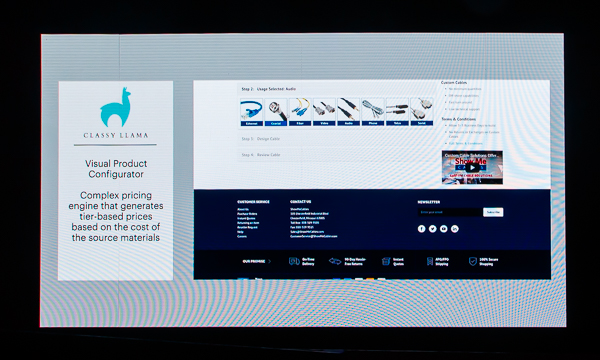
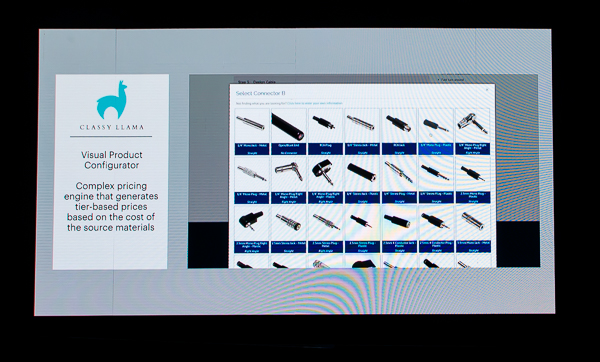
Next up: Amazon’s VP of International Marketplace & Retail, Eric Broussard.
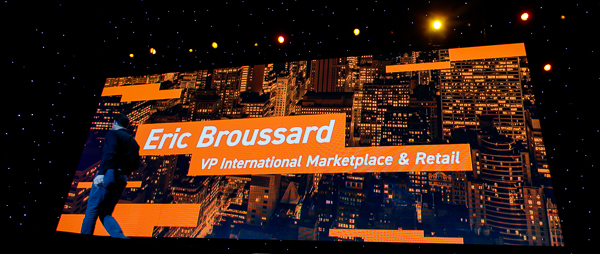
This was exciting for me, because it featured some of what our company has worked on in the past year, including some contributions we made to the Magento core code.
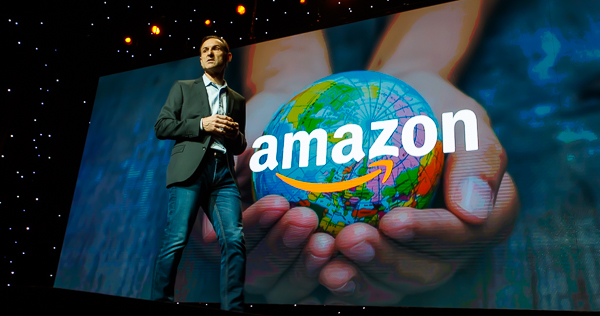
Broussard talked about Amazon in the early days:
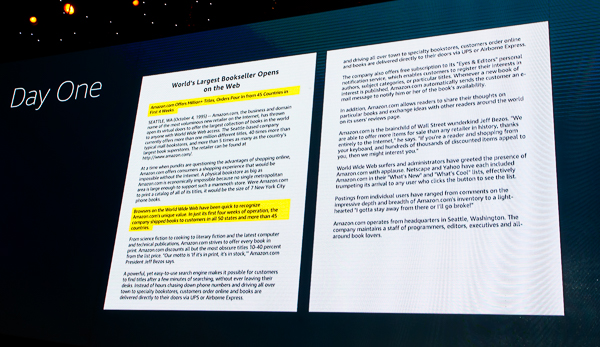
He showed a press release from October 4, 1995, when the "World’s Largest Bookseller Opens on the Web." At the time, they offered more than a million titles, and in their first four weeks, they shipped books to customers in all 50 states and more than 45 countries:
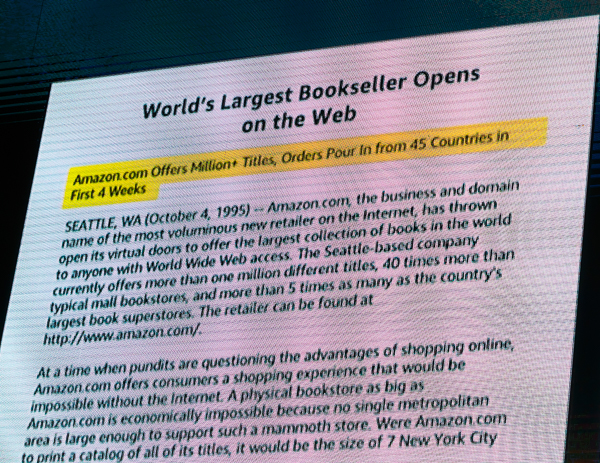
Broussard highlighted Amazon’s vision:
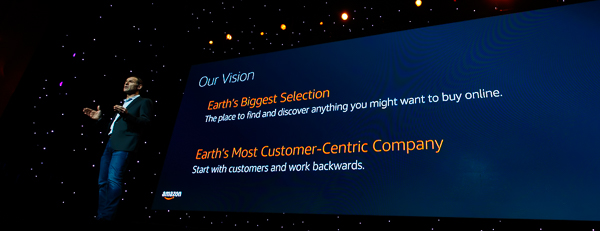
- Earth’s biggest selection: the place to find and discover anything you might want to buy online.
- Earth’s most customer-centric company: Start with customers and work backwards.
Broussard talked about how it took a little while to get to where they are now:
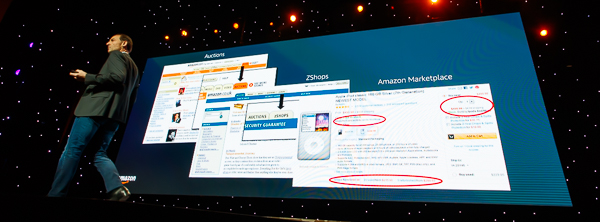
- For example, Amazon first started out with an "Auctions" tab on their site, where people could sell random items.
- That moved to ZShops a few years later.
- And then finally, to Amazon Marketplace. Because Amazon found that customers were searching for a specific product, such as an iPod.
In that case, the customer could see a page with the product information, and then options to purchase it from Amazon, or from other sellers in the third party marketplace.
Broussard gave a few Amazon stats for 2017 (I know from experience that these numbers are sometimes difficult to track down):
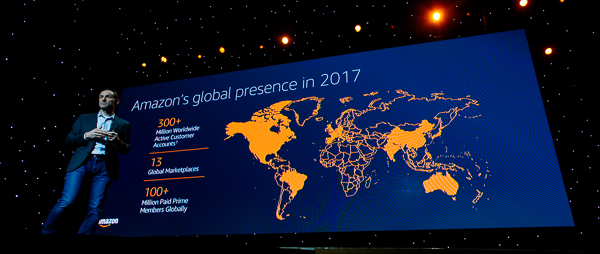
- Amazon has 300+ million worldwide active customer accounts
- Amazon sells in 13 global marketplaces
- Amazon has 100+ million paid prime members globally
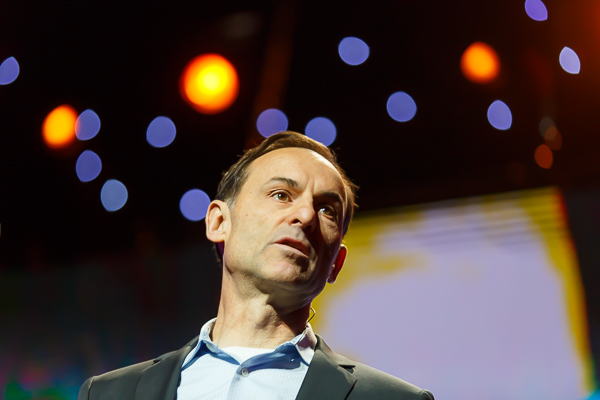
Broussard spoke about how merchants can leverage the same technology that powers the Amazon.com site, including:
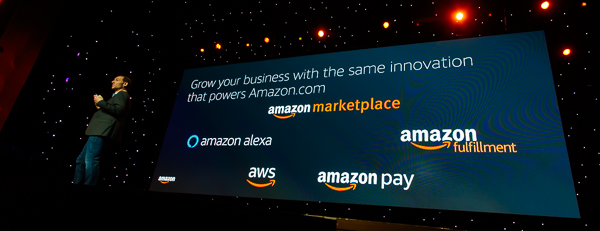
- Amazon Marketplace (allows merchants to sell in the third party marketplace)
- Amazon Fulfillment (letting Amazon handle shipping and fulfillment, and allow you to gain access to Prime customers for Prime shipping)
- AWS (scalable web hosting)
- Amazon Pay (allows your customers to pay using the stored payment methods and addresses in their Amazon account)
- Amazon Alexa (for voice-enabled eCommerce)
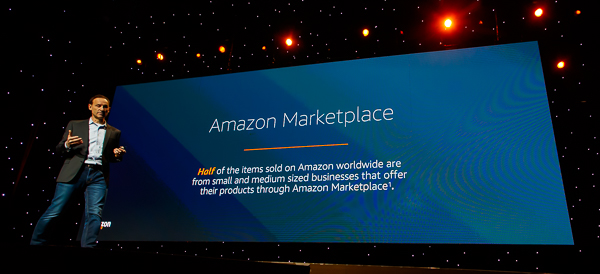
Broussard told the group that 50% (half) of the items sold on Amazon.com worldwide are from small and medium sized businesses that offer their products through Amazon Marketplace.
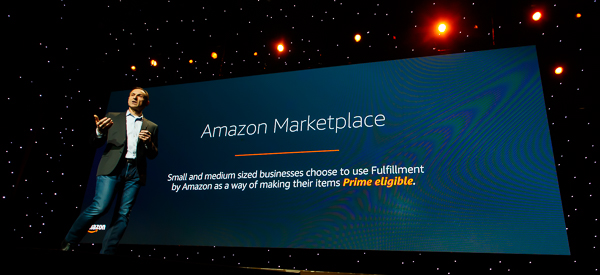
Small businesses shipped billions of items worldwide with Fulfillment by Amazon (FBA) in 2017:
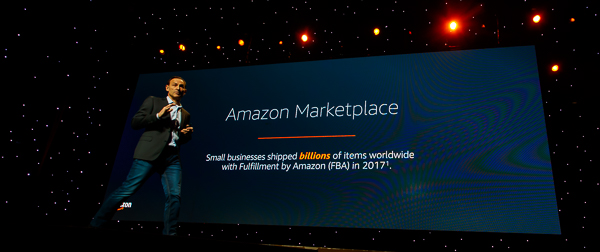
Amazon has 175+ fulfillment centers worldwide, including 15 in Japan and 31 in Europe:
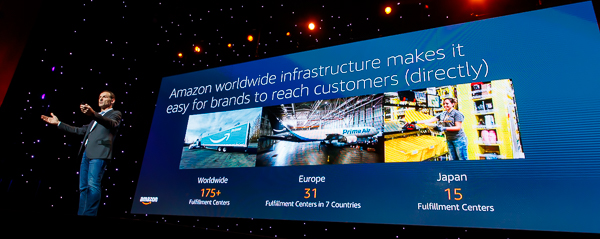
And Amazon makes it easy to sell cross-border. Cross border e-commerce now represents more than 25% of total third-party sales:
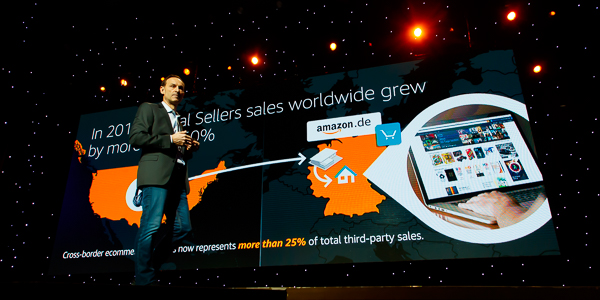
Broussard talked about Magento integrations with Amazon:
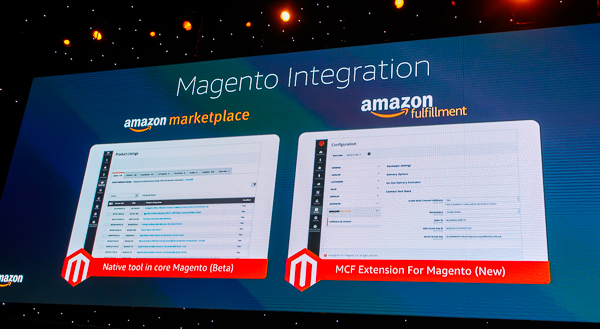
- Amazon Marketplace (which I spoke about last year at the Imagine Conference)
- Amazon Fulfillment
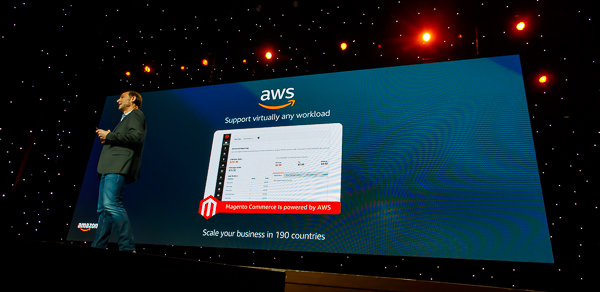
… And Amazon Pay, which allows end users to be able to log into their Amazon account and check out at a Magento site, using their stored payment methods and address book:
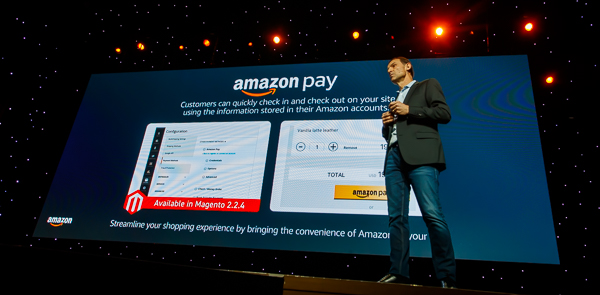
On the Amazon Alexa front, Amazon launched Amazon Pay for Alexa Skills, that is now being used by TGI Fridays, 1-800-Flowers.com and the American Red Cross:
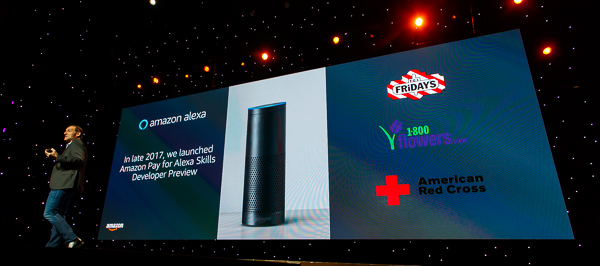
Broussard closed by showing an early job posting for Amazon.com:
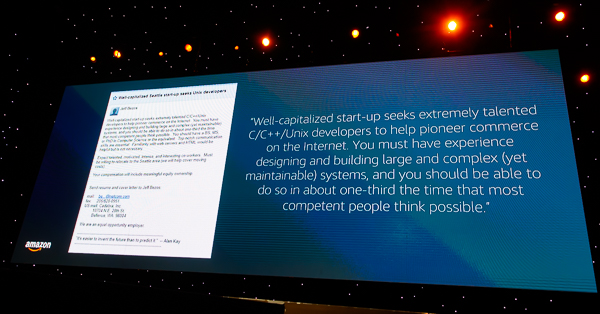
My favorite lines: "You must have experience designing and building large and complex (yet maintainable) systems, and you should be able to do so in about one-third the time that most competent people think possible."
That and, "Familiarity with web servers and HTML would be helpful but is not necessary."
Broussard left us with a quote by Alan Kay, "It’s easier to invent the future than to predict it."
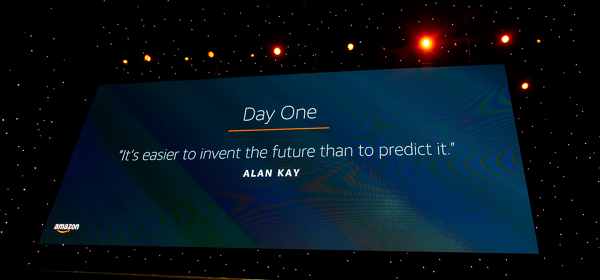
Closing out the keynote was Jason Silva, a futurist and host of the National Geographic show, Brain Games.
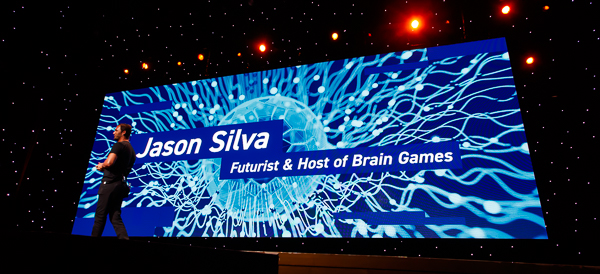
He spoke fast, was inspirational, and talked about how everyone now has the tools of gods (a smartphone) that only 20 years ago was 1,000 times slower and took up an entire building.
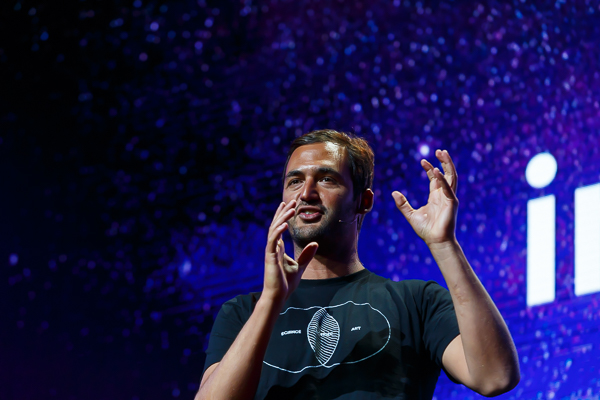
Through videos and more, he attempted to get the audience to experience a sense of awe. "An experience of such perceptual vastness you literally have to reconfigure your mental models of the world to assimilate it."
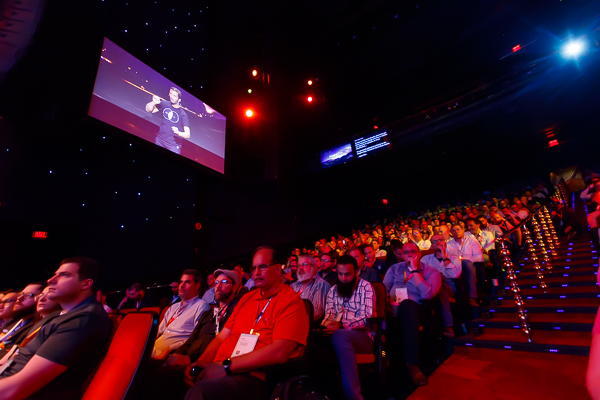
After the keynote, I went back to the exhibit hall, and watched people color in the mural:
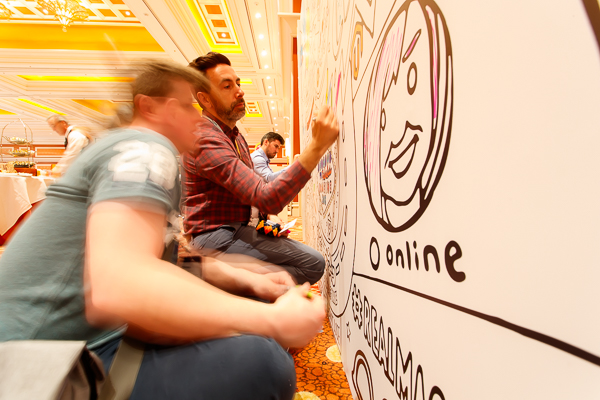
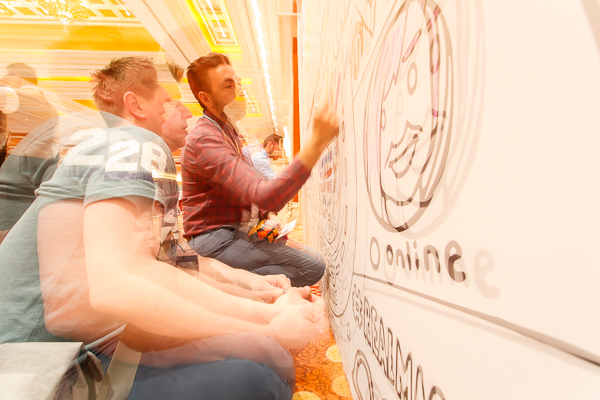
I watched Melissa Ben-Ishay be interviewed:
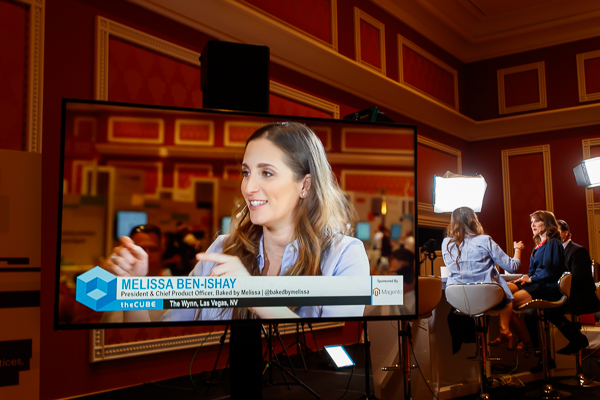
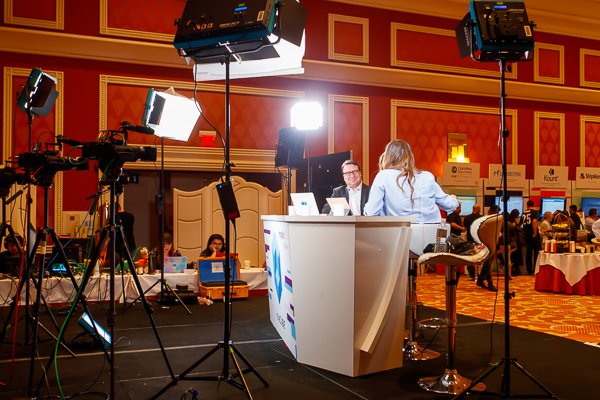

And watched a few Magento evangelists discuss what’s going on with Magento 2.2 from the Podcast booth.
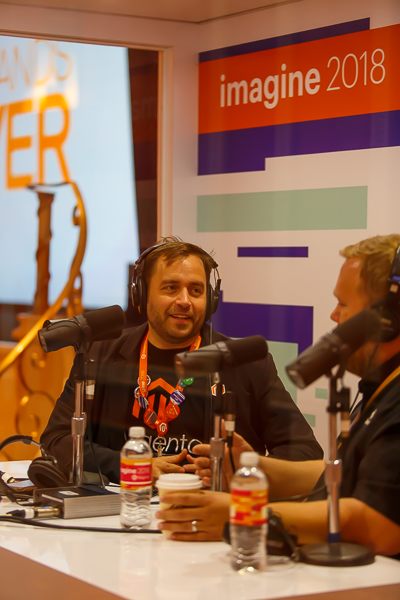
Tucked away in a corner of the exhibit hall Jesse Kruchoski, the Partner Manager for Amazon Pay, gave an overview of the Amazon Pay integration.
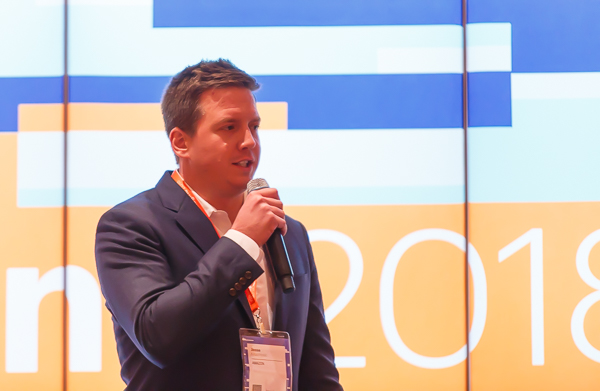
It’s now available in the Magento code, version 2.2.4.
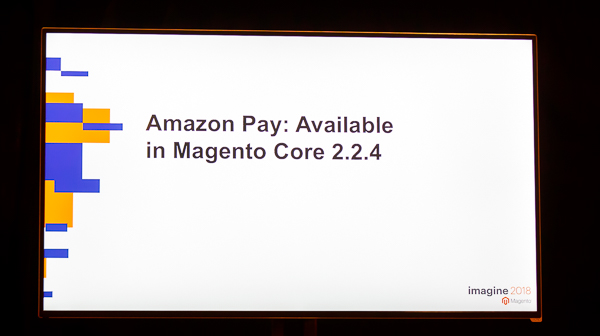
And unlike other previous attempts to integrate Amazon Pay into the system, this version is pretty seamless.
First, the obligatory Amazon.com statistics:
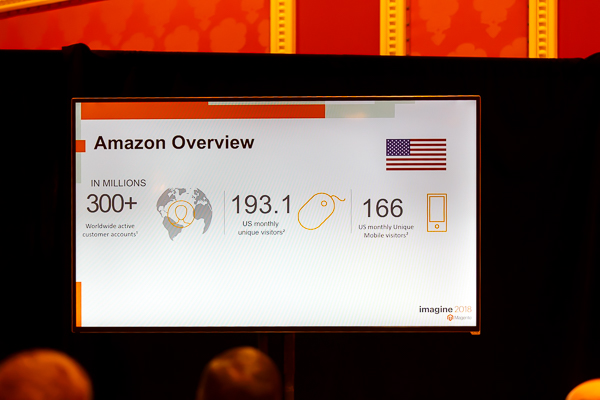
- Amazon has 300+ million worldwide active customer accounts, as of 2017
- Amazon.com has 193.1 million unique visitors per month in the US (2017)
- Amazon.com has 166 million unique mobile visitors per month in the US (2017)
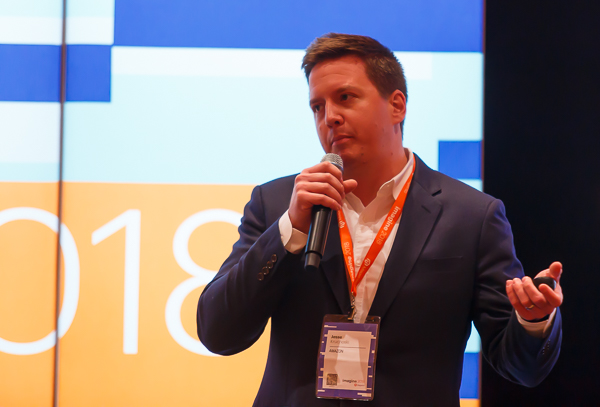
According to Kruchoski, Amazon Pay makes it simple for hundreds of millions of customers around the globe to check-in and checkout on your sites using information already stored in their Amazon account:
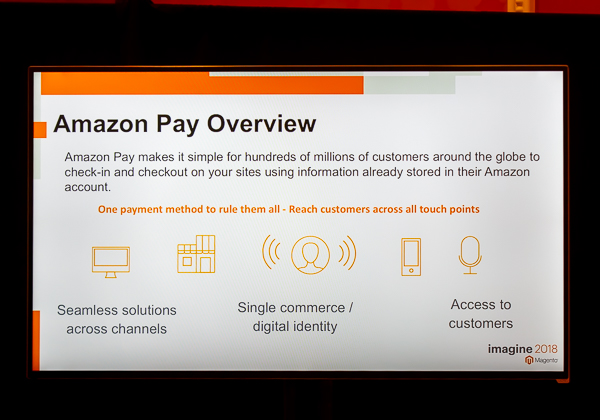
For Magento Merchants, Amazon Pay allows you to have:
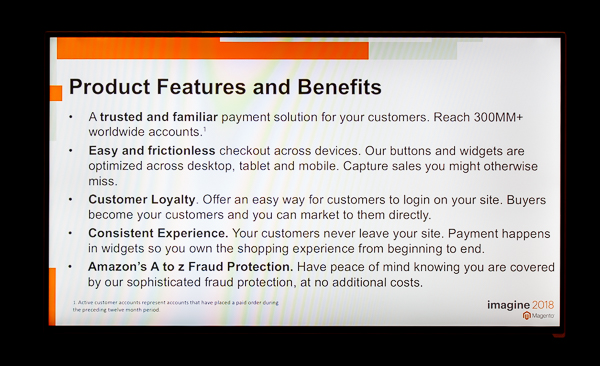
- A trusted and familiar payment solution for your customers, and reach more than 300 million users worldwide.
- Easy and frictionless checkout across devices.
- Customer loyalty, and allows you to be able to become your customer (unlike the third party marketplace, where this is not allowed).
- Customers don’t have to leave the site (think older PayPal Express Checkout systems that take the end user to a different place). It’s all integrated and very seamless.
- Amazon’s A to z Fraud Protection. Sellers using Amazon Pay are covered by fraud protection – so they don’t have to worry that someone placed an order using a stolen credit card.
According to Kruchoski, Amazon pay is available now for merchants in the IUS, UK, and much of the EU.
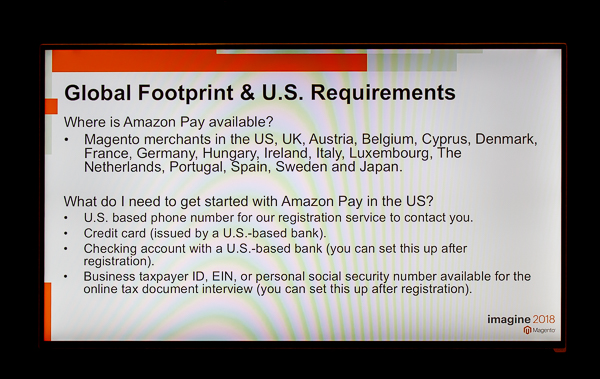
In the US, you need a phone number, EIN, and a US-based checking account and credit card.
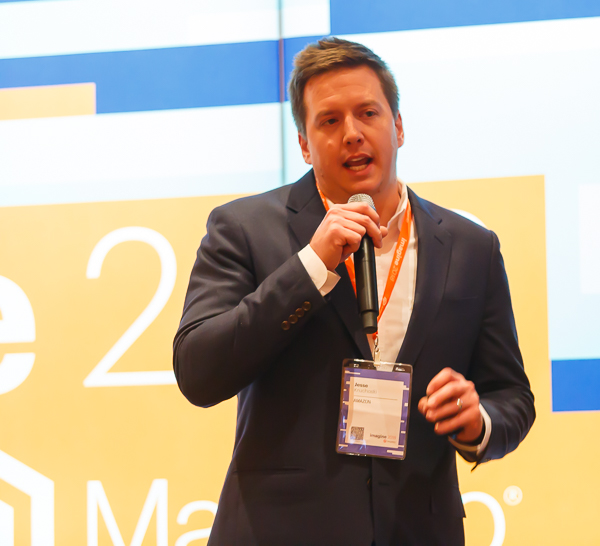
Current Magento stores using Amazon Pay include:
- US-Mattress.com
- Kraf Music
- Shinola Detroit
- Fanzz
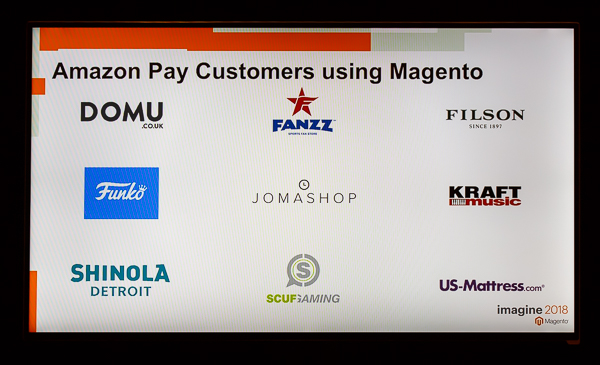
Domu, an outdoor online retailer, found 50% higher mobile conversion rates and 41% more customer transactions after implementing Amazon Pay.
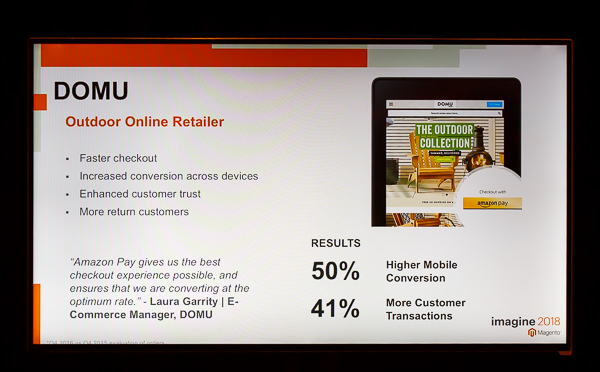
Shinola found 40% faster checkout and 19% more mobile users after implementing Amazon Pay into their Magento site.
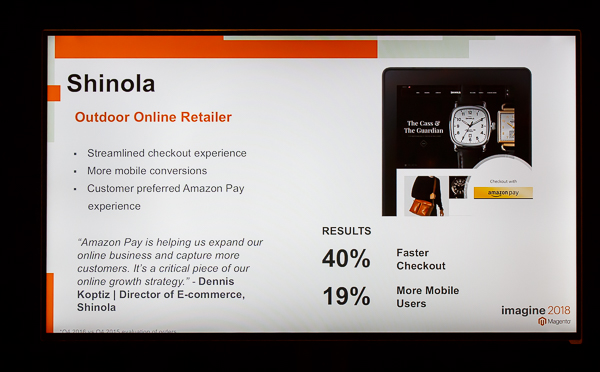
The Amazon Pay Front-End experience starts with a button on the cart page:
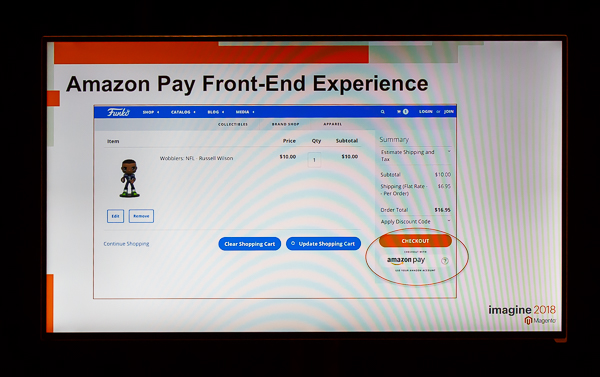
Next, the end user sees an Amazon login page appear, where they can log in with the email address and password they use for their Amazon account:
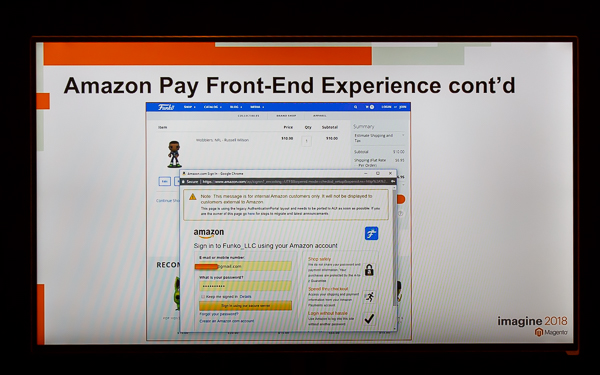
The customer next selects the shipping address and shipping methods: (FYI, those yellow scrolling lines in the background are part of the Powerpoint template that was used for the show, and not an artifact of the screen.)
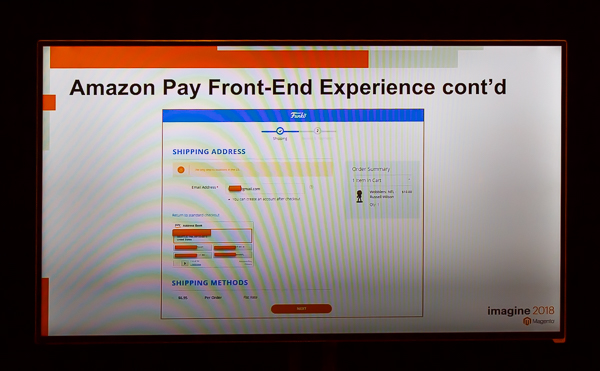
Next, the end user selects the payment method they want to use, that is stored inside their Amazon profile, and clicks "Place Order."
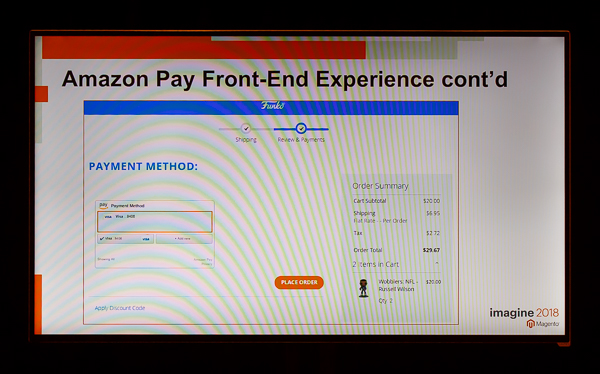
From the Magento admin, activating the extension is pretty easy, and is all done through the Magento admin panel:
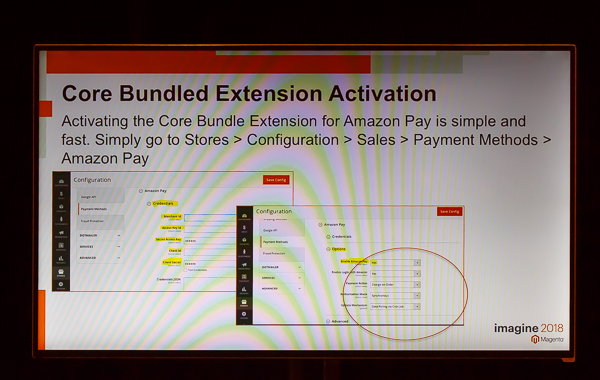
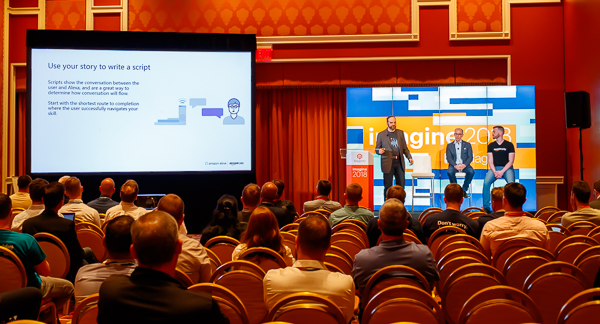
Next up – I attended the "Alexa, Order Me A…" session.
Full disclosure: I’ve got a few Alexa devices in the house, and love to be able to ask about the weather, play music or control the lights or thermostat. Kind of cool. Kind of like the Star Trek computer coming to life (in a very limited way). I still get a kick out of asking Alexa to turn off my bedroom lights (or turn them blue).
The breakout session was led by:
– Franklin Lobb, Sr. Solutions Architect at Amazon
– Matt Nielson, Sr. Solutions Architect at Amazon
– Bruce Salerno, Go-To Market Manager at Amazon
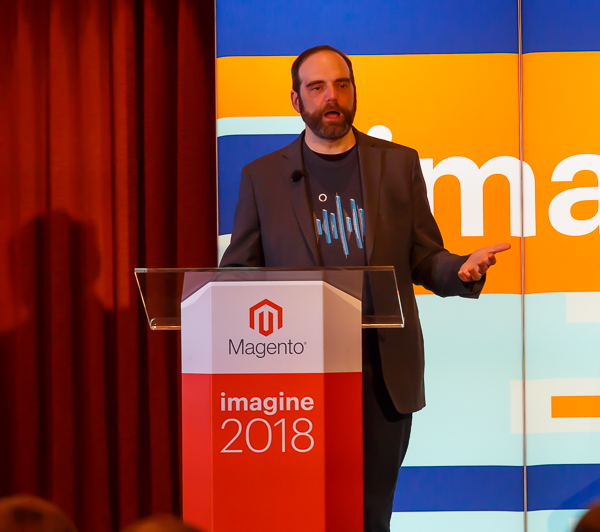
The first step according to the team, is to create your user story:
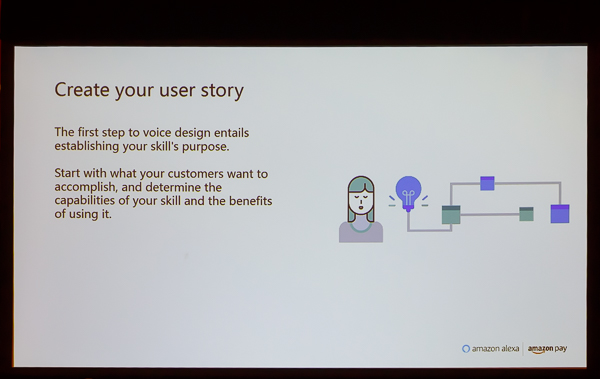
… and then use that story to write a script. They recommend starting with the shortest route to navigate the skill:
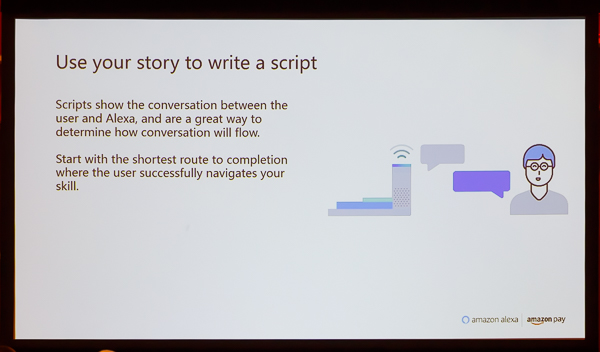
Here’s an example:
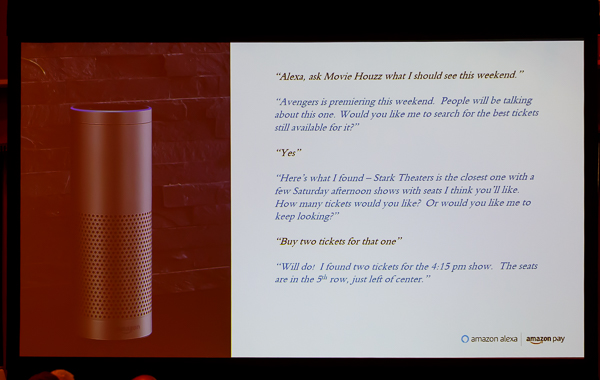
The other thing to pay attention to, according to the Amazon Alexa team, is to keep in mind that users will often go off script:
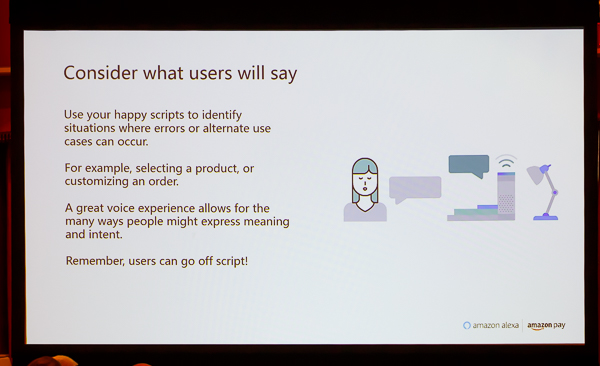
They covered things to Do, and things to avoid when programming Alexa skills:
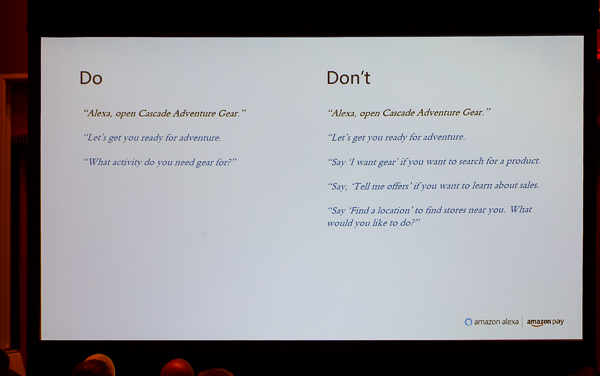
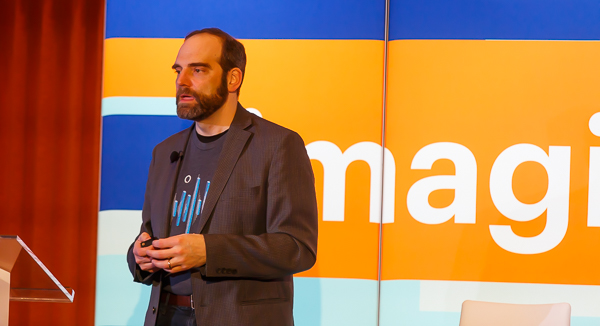
Finally, before you start building, they recommend checking your design and testing it out with your voice:
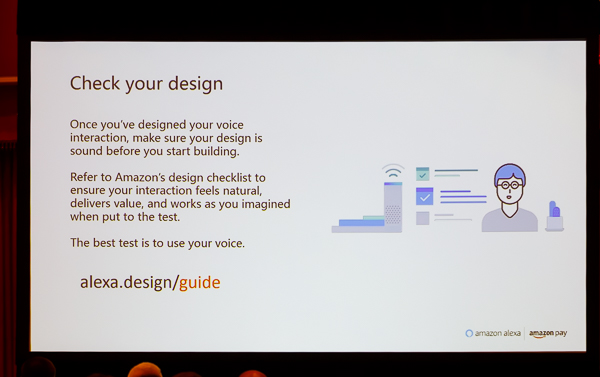
To build commerce for voice, there are four main components:
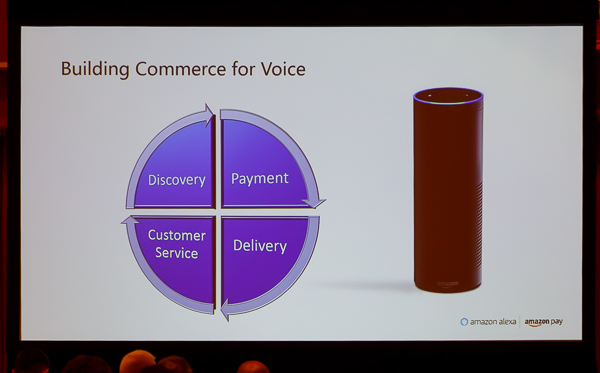
- Discovery: figuring out what the customer will want to buy.
- Payment: selecting a payment method
- Delivery: choosing a shipping or delivery method
- Customer Service: to check on orders, address customer issues
When trying to close the sale, the Alexa team encourages merchants to be clear about what’s being purchased, including total items, the payment total, and timing for delivery.
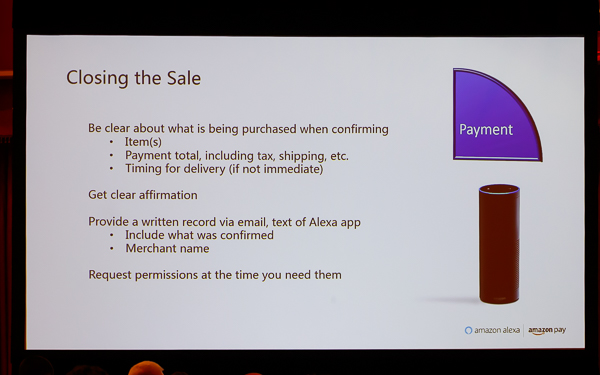
They also recommend a written record via email, including the merchant name:
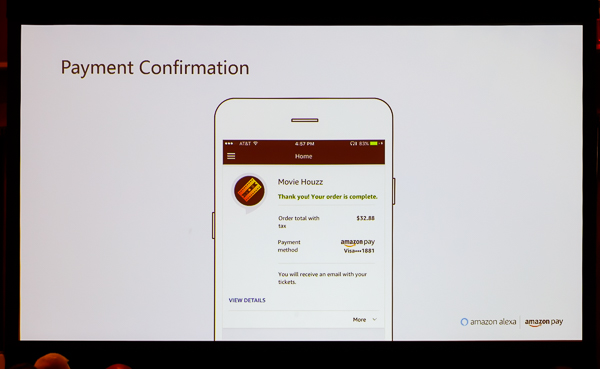
For Customer Service, they recommended obsessing over the customer experience:
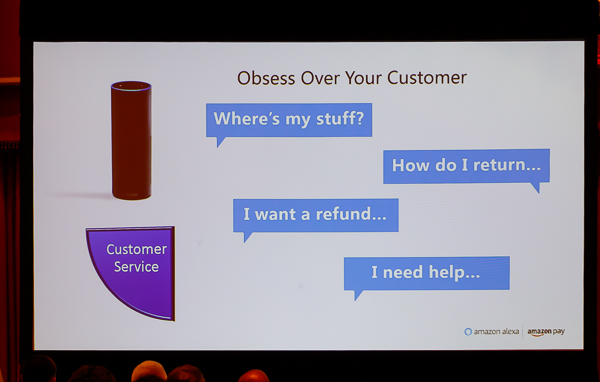
The Alexa team recommends using Amazon Pay for Alexa skills. In the past, the only option was to use the account linking option, but that required the end user to have to log into via the Alexa app with their username and password. Amazon Pay makes it a lot easier, and no additional login is required:
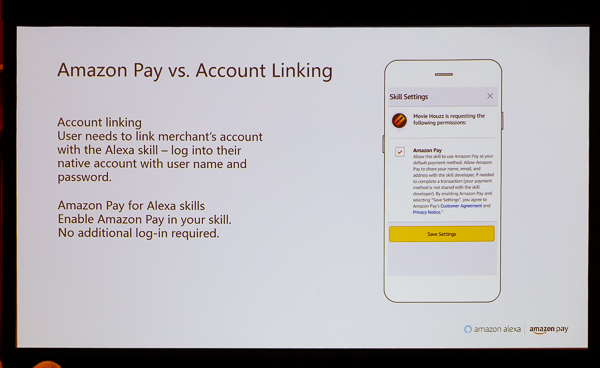
The Alexa team showed a few technical details on how to invoke the Amazon Pay for Alexa skills, including the required inputs and outputs for processing payments and setup:
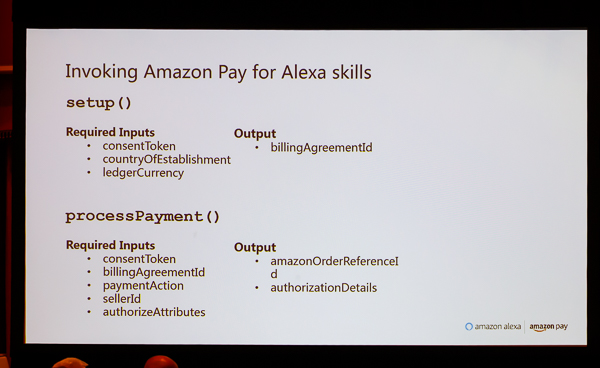
They also gave quite a few links to resources, including Amazon developer accounts, AWS hosting, and Amazon Pay:
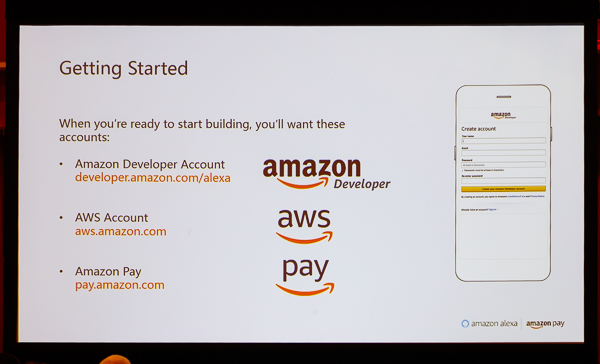
… as well as design resources:
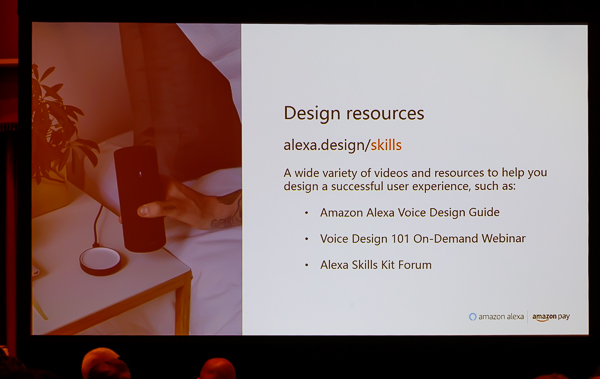
Featured Keynote (Tuesday Night):
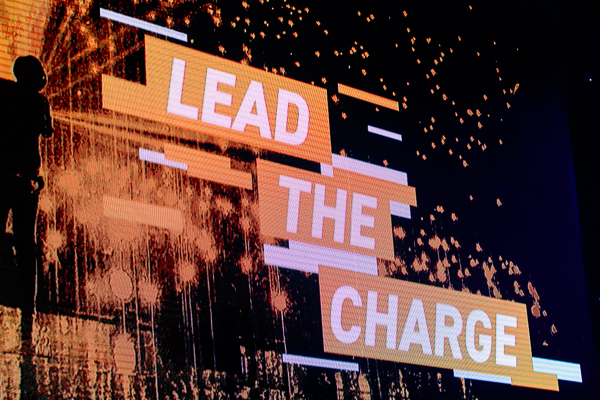
At last it was time for the featured keynote, where Jamie Foxx was going to be featured.
It was a big crowd – I got there super early to get a front row seat:
Phillip Jackson was back, and introduced Andrea Ward and Gary Spector who presented the Imagine Excellence Awards, with a little help from Mark Lavelle:
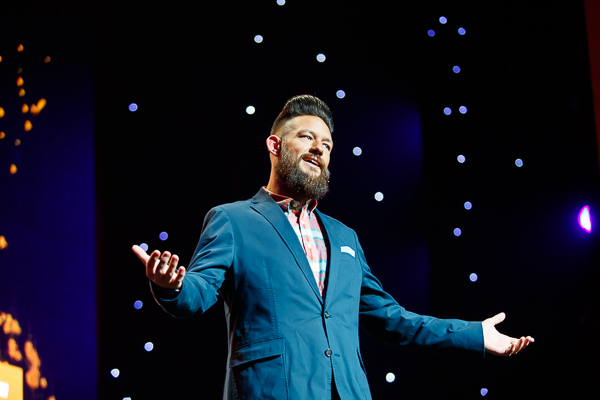
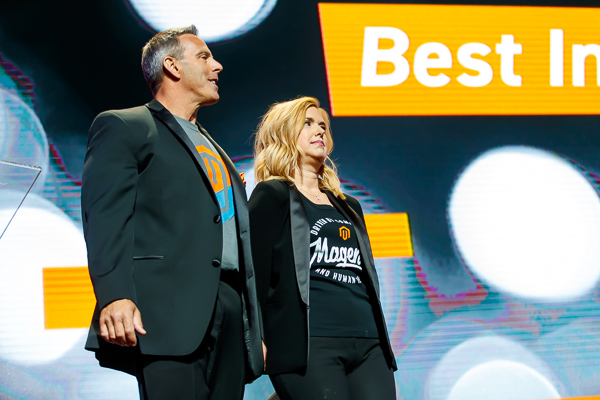
Rural King won best in class fulfillment:
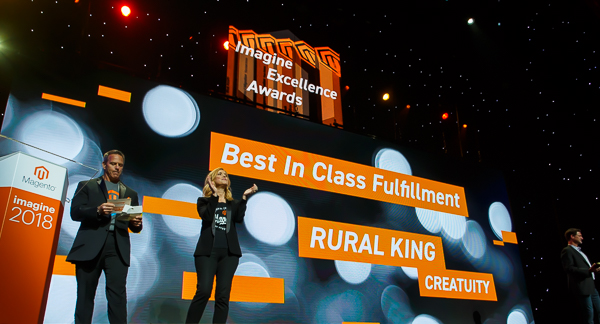
The Global Expansion award went to Dufry.
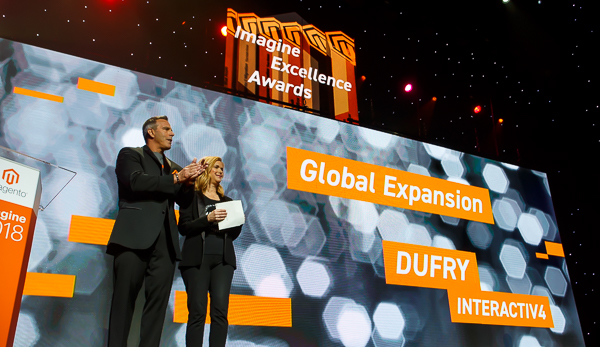
Best B2B Innovation went to ABInBev:
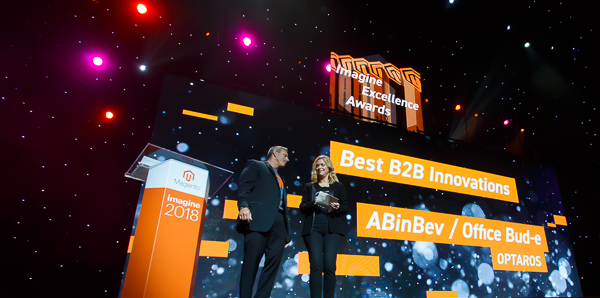
The most innovative customer experience went to Ebowie.pl
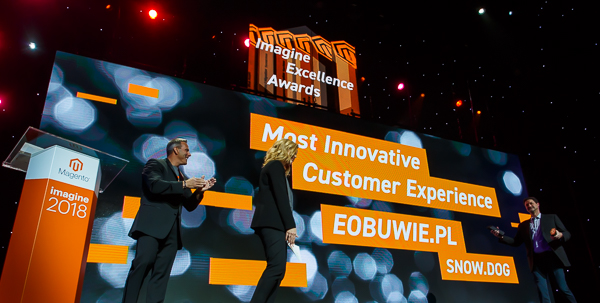
And the Commerce Leader of the Year went to Mark Teperson of the Accent Group.
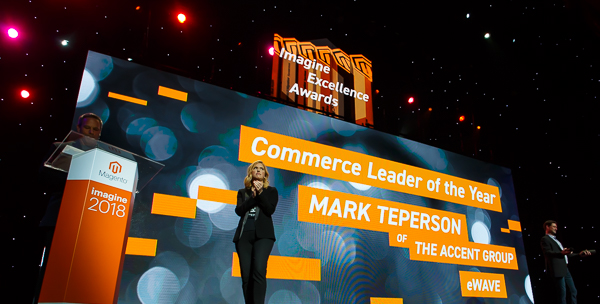
Finally, it was time for Jamie Foxx:
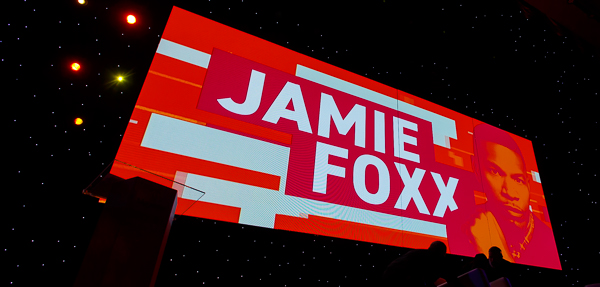
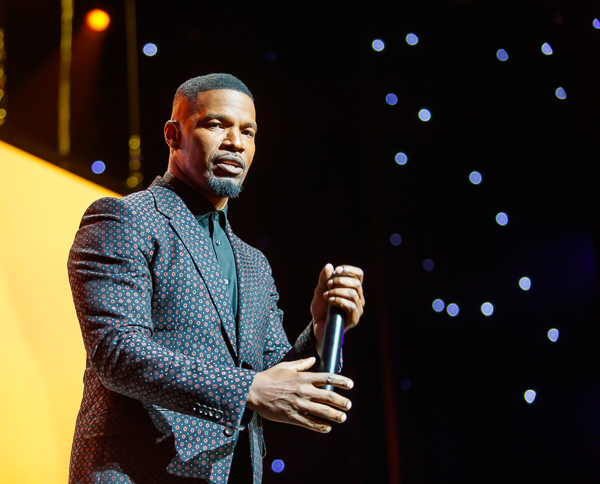
He was posing for me:
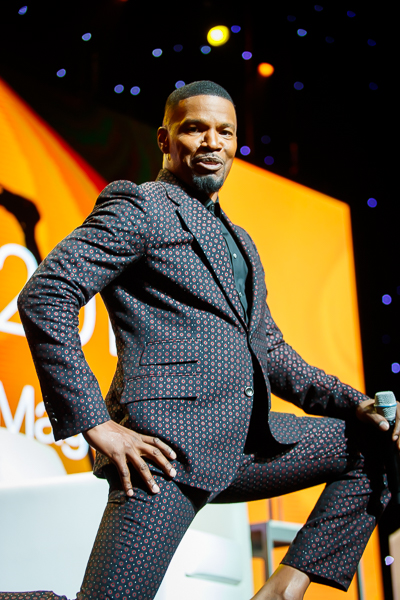
He invited Jessica, a Magento developer onto the stage for a hug and a photo (they had met a few years earlier):


Mark Lavelle then started the questions:
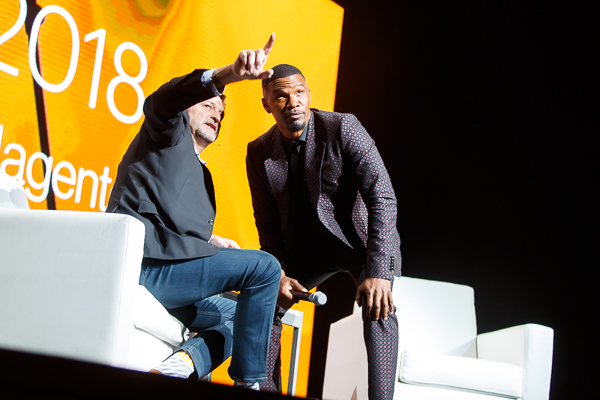
Foxx told the audience how his grandmother made him play the piano for church, and that’s why he was successful in the Ray Charles film.
Foxx told us how he got the name Jamie Foxx. He was having trouble getting into comedy clubs because he was a man. So he started using gender neutral names. Jamie Foxx stuck.
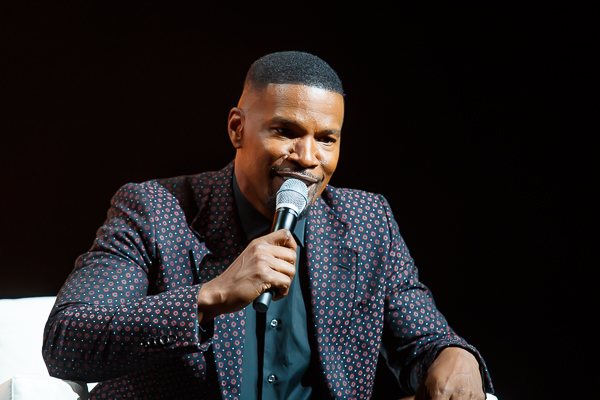
Foxx talked about how he used A-B split testing in comedy.
And how he would go to an all black comedy club, and test out white material. And if part of it worked, he knew he could incorporate it into his standard routine.
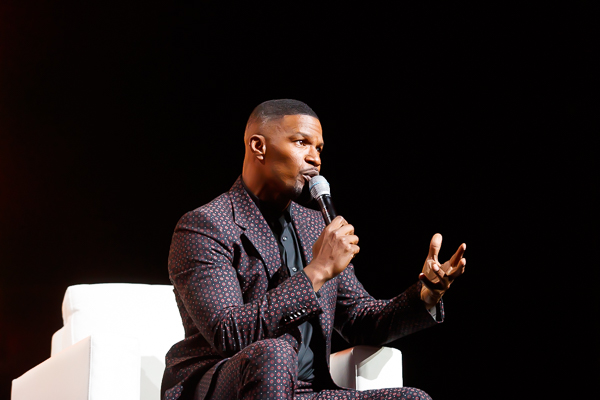
He also tested out black comedy on a white audience to see what resonated.
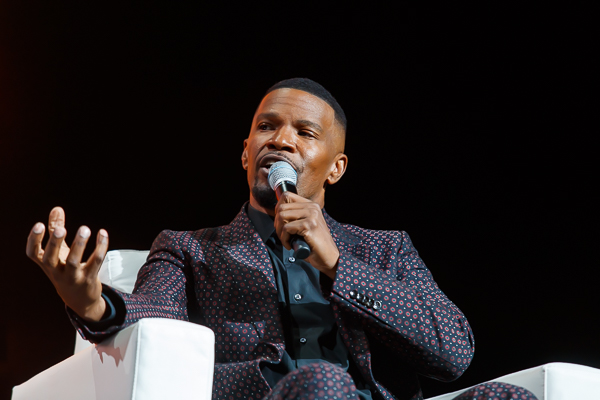
He told about doing social media and promotion via pagers and early cell phones, so that he could let people know when he was going to be visiting.
He has a pretty encyclopedic knowledge of telephone area codes. St. Louis – he’d say 314. Because he traveled the country and learned about the local areas.
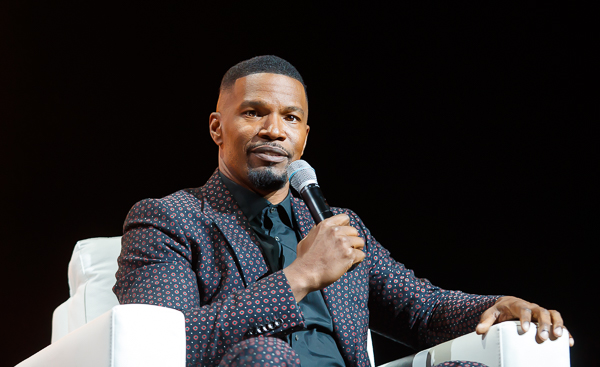
He’s a Magento Commerce Cloud customer – he started a sunglasses line.

The inspiration? He was wearing a pair of sunglasses and was photographed… and everyone wanted to know what he was wearing. Prada? Gucci? Something really expensive?
He said, no… it was a pair that he picked up from a gas station.
What he found was that people wanted to wear things that he and other celebrities wear. But if he wore a $450 pair of sunglasses, it put distance between him and his fans. Instead, he wanted to launch a line of sunglasses where the average price is closer to $30.
Here’s Jamie Foxx with a set of these sunglasses:

And Mark Lavelle rocking a pair:

Here’s a closeup:
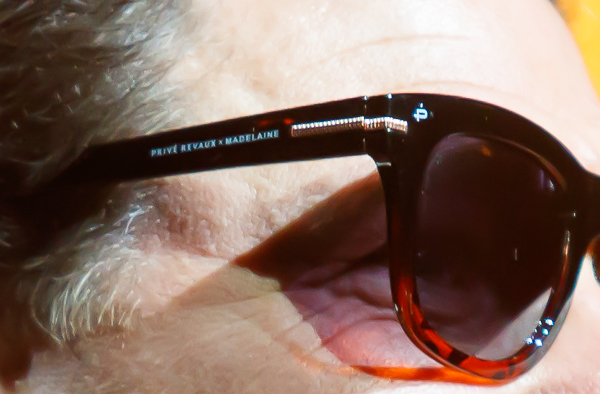
I also think it looks great in black and white:

No speech is complete without a few audience high-fives:
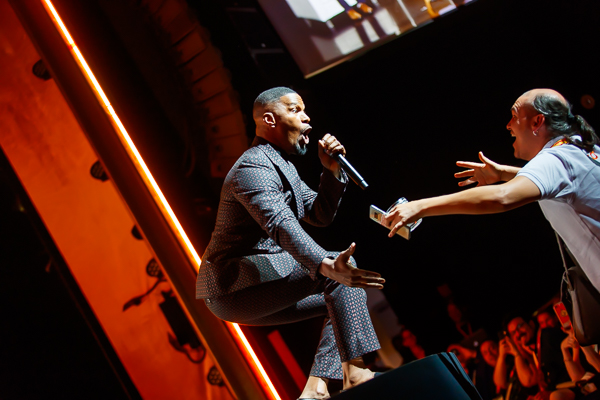
Including this one of my former colleague, Lonny:
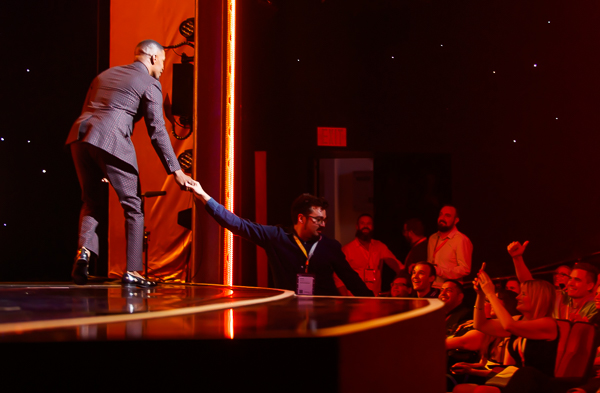
Phillip Jackson closed out the night…

And I thought this just looked too good not to go with black and white as well:
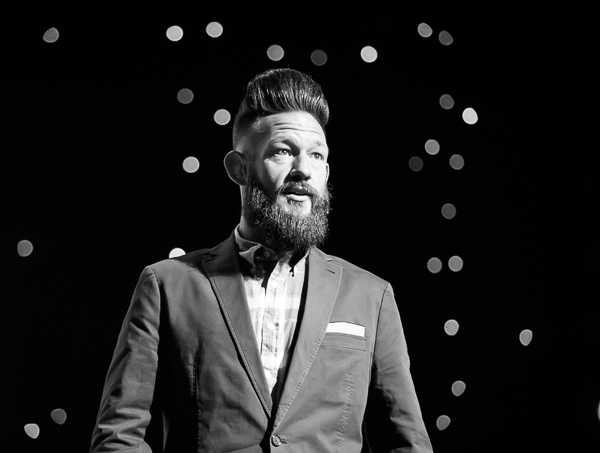
Right after, I took a nice photo of Jackson and his wife, whom I thanked for sharing him so much with the Magento community. (She gave the Magento ecosystem a big, "You’re welcome!")
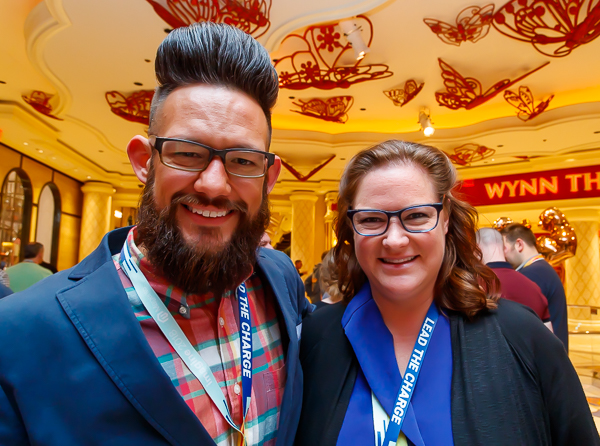
Then, off to the Legendary Party, at the Encore Beach club.
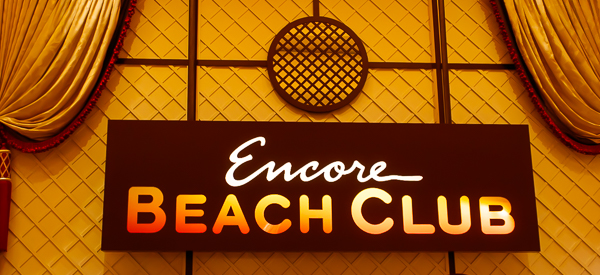
It was a great party, with a lot of music, drinks and LED flashy stuff.






I took a bunch of photos of friends in front of the Imagine sign:
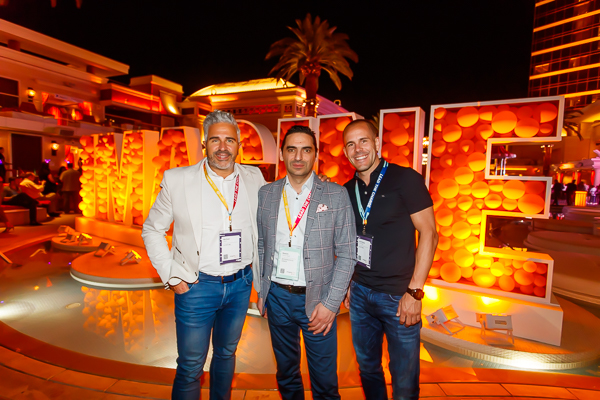
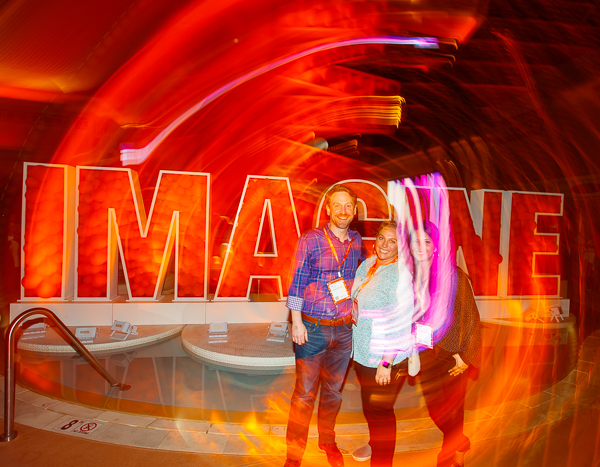
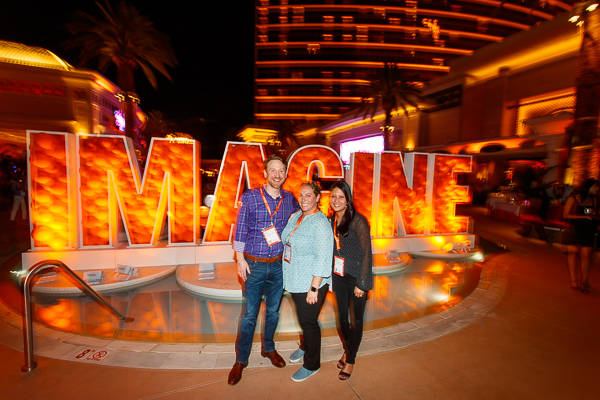
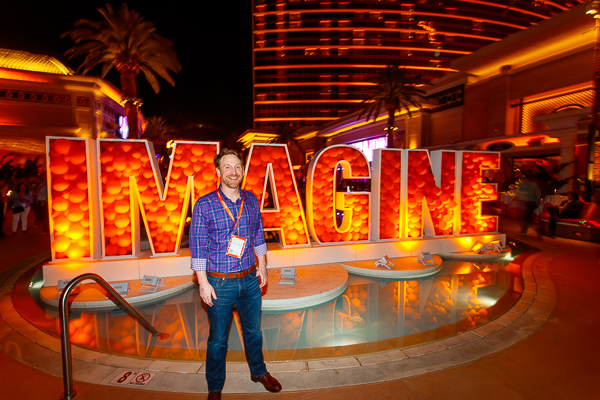
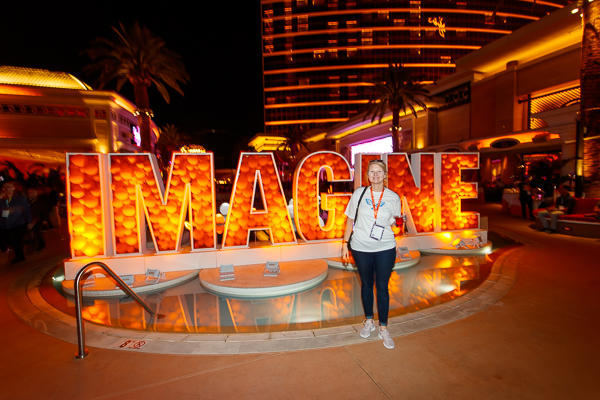
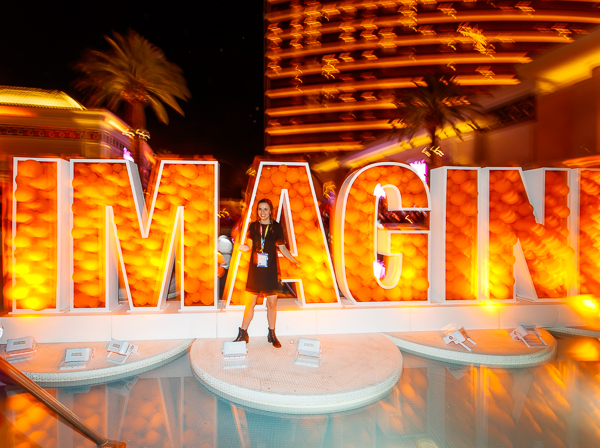
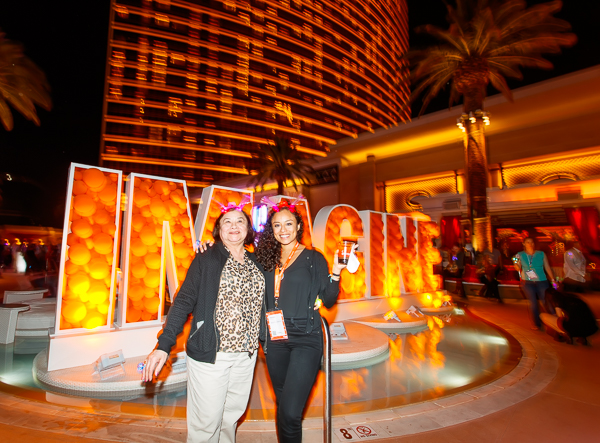
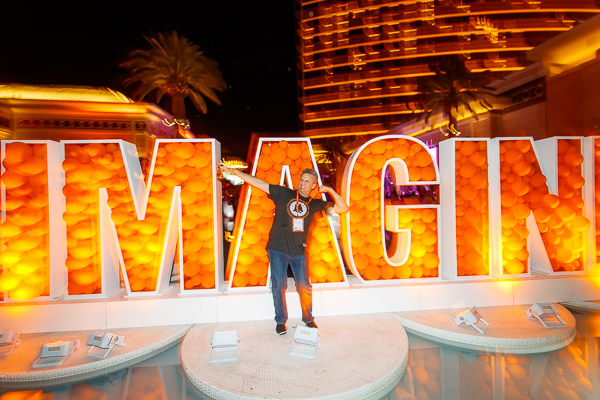
And I also got a little creative by using a little rear-curtain flash synch, and moving the camera to create light trails:

For this shot, I used a Canon 1DX Mark II with a 17 mm lens, set it at f/8.0, ISO 320, and 1/2 second exposure. I clicked the shutter button, rotated the entire camera body 90 degrees, and then had the flash fire at the end of the exposure. The camera motion created the swirling light trails, while the external flash mounted in the hotshot fixed the outlines of the sign at the end.
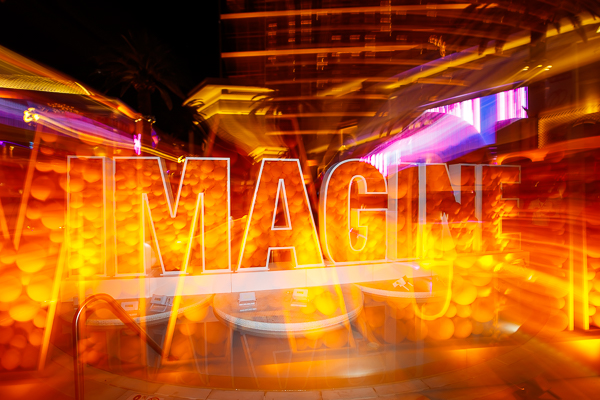
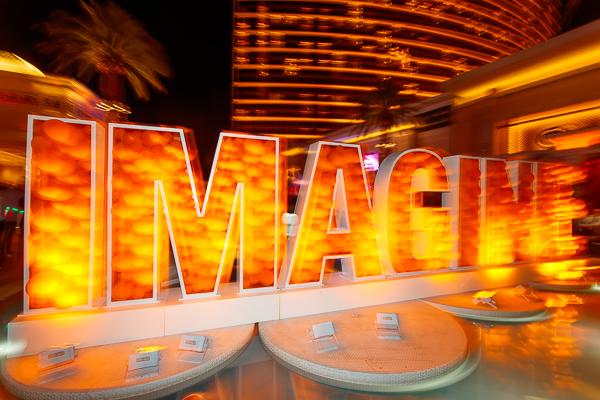
Day Three: Final Day
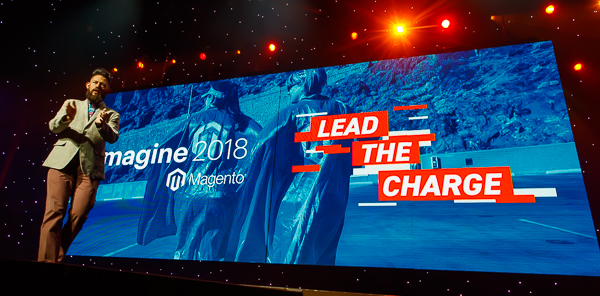
I did manage to get home relatively early from the party, so I took Phillip Jackson’s advice and put on my running shoes and went for a run on the Las Vegas strip.
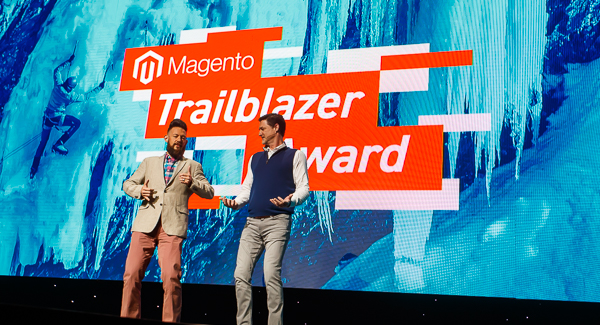
Imagine 2018 was coming to a close with a final keynote presentations.
A couple of trailblazer awards were presented:
Andrew Devlyn – Devlyn
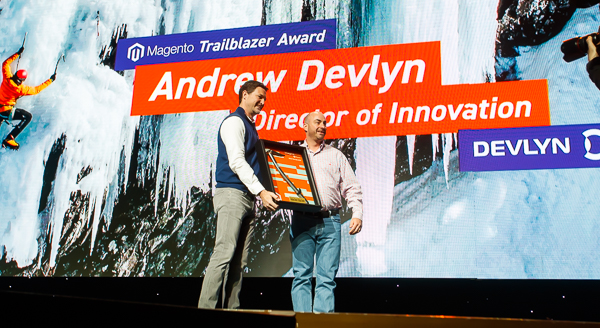
Eric Zillmer – Steelcase
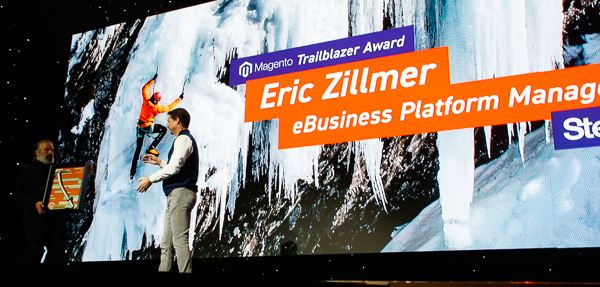
Turns out that the electric bike sold via Twitter for $4,000 to Chase Lonard to support the Make A Wish Foundation:
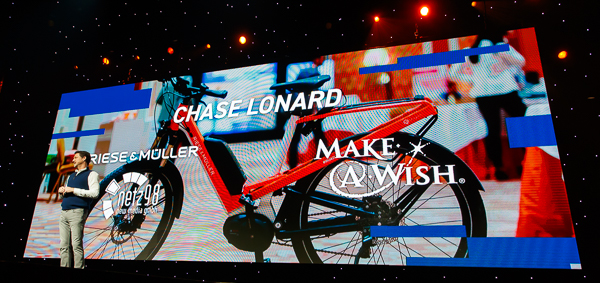
Next, Andrea Ward gave a bit more marketing data about the platform.
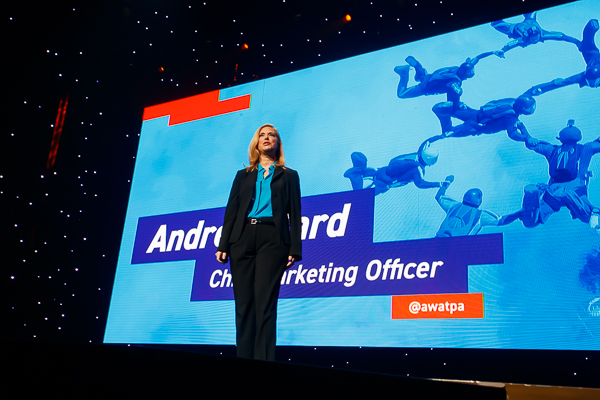
First movers, for example, saw their 3 year revenue growth expand 2x faster than people who waited to embrace new technology.
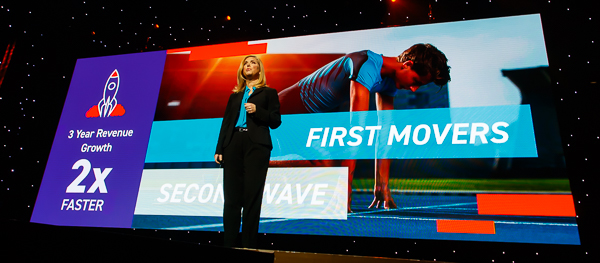
Her talk focused on how Magento is a flexible platform that allows merchants the ability to say "Yes, And…" Online & In-store; B2B & B2C. In the cloud & on-premise.
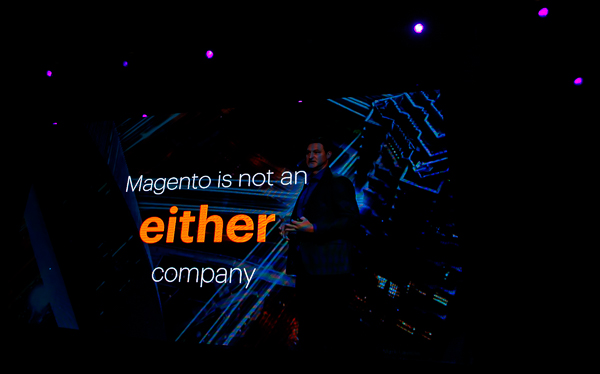
Next, Jason Woosley, SVP at Magento, rose out of the stage.
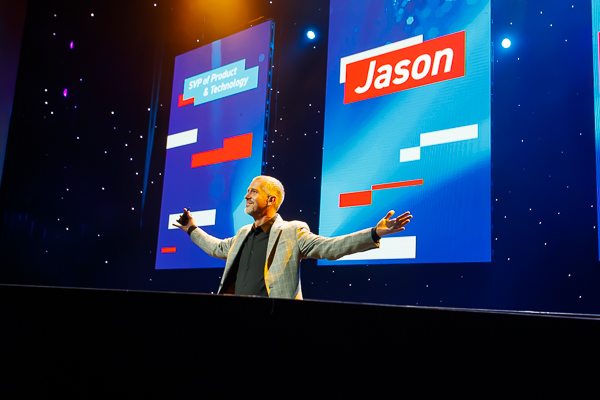
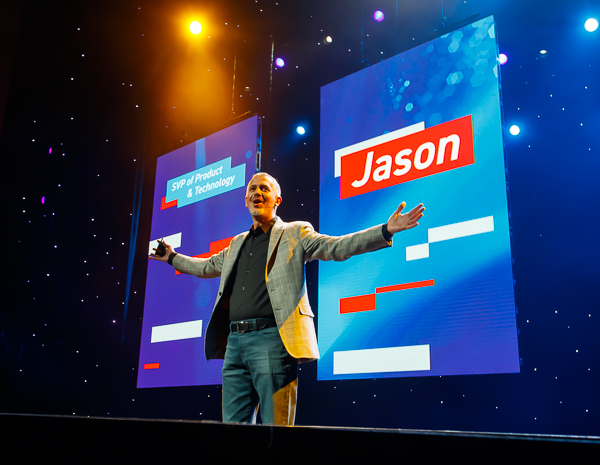
Honestly, this is my favorite part of the whole show. Yes, it’s nice to have an A List celebrity talk about their eCommerce sunglass store, but I love seeing what’s new with the platform and product. (Especially since our company worked on some of what was being rolled out.)
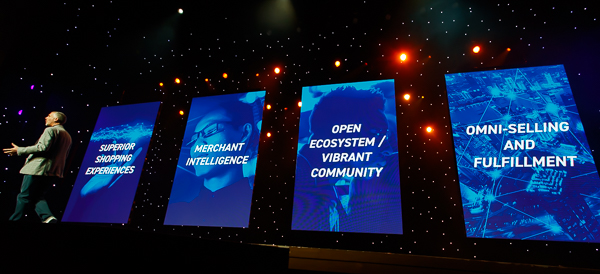
The four screens split apart, and focused on the four areas Magento is trying to promote:
- Superior Shopping Experiences
- Merchant Intelligence
- Ecosystem / Vibrant Community
- Omni-Selling and Fulfillment
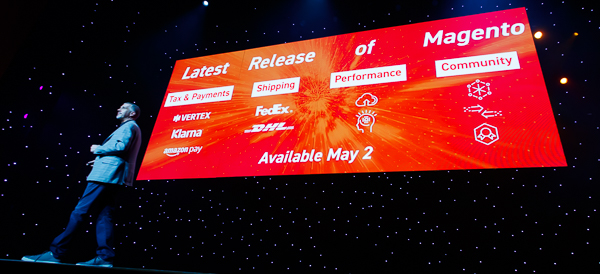
The latest release of Magento has a number of new technology built directly into the core, including:
- Tax & Payments:
- Shipping:
- FedEx
- DHL (in the core for the first time)
- Performance:
- A rising cloud icon – probably symbolizing a scalable hosted solution
- A microchip embedded in a brain with a glowing scalp. Not really sure. Probably machine learning or artificial intelligence. But perhaps they’re going to put chips in our head? (Time for that tinfoil hat.)
- Community:
- Hexagonal, cross functional diagram, symbolizing people working together?
- Two arrows, rapidly pushing toward each other, but barely missing.
- What appears to be an award – perhaps this is the evangelists?
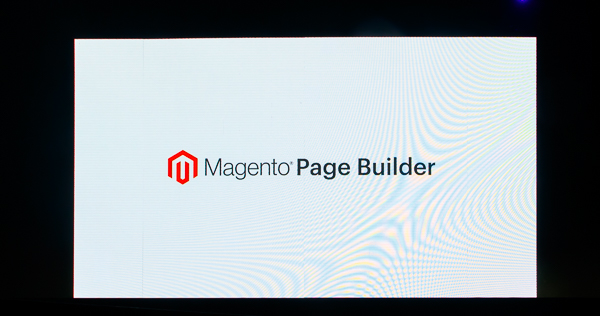
Product Release #1: Magento Page Builder:
Magento acquired the Bluefoot CMS tool about a year and a half ago, and have now integrated it into the system as an easy-to-use CMS platform.
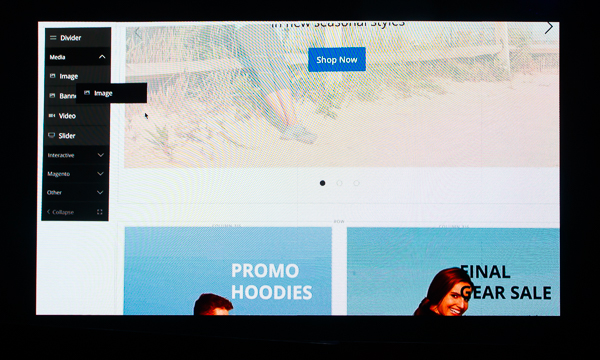
Page Builder makes it easy for non-technical users to be able to update the home page or other areas of a site quickly and easily.
Here’s a screenshot of the process:
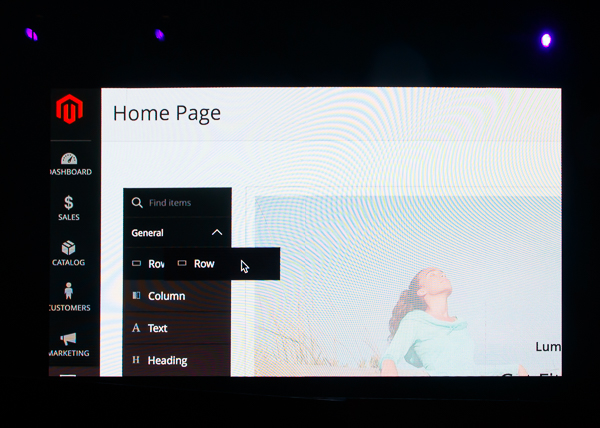
Further, you can schedule new updates, so that content can be published in the future:
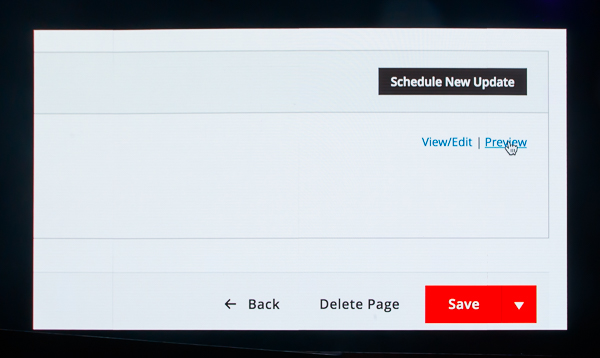
There’s drag and drop functionality:

And the ability to create callouts on top of big hero images:
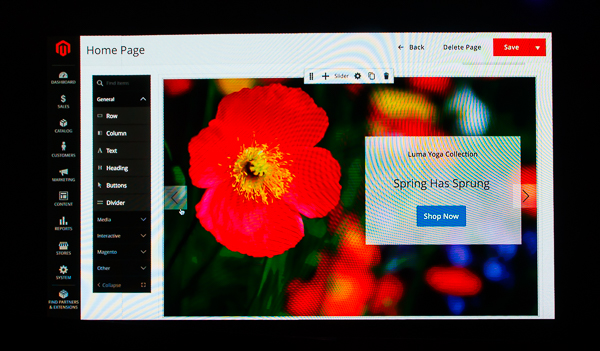
A note of caution: this system will only work if you are using Magento’s built-in CMS blocks and layouts. If you have a developer build out a completely custom design, they’ll need to build in the "hooks" for the Page Builder system to work properly.
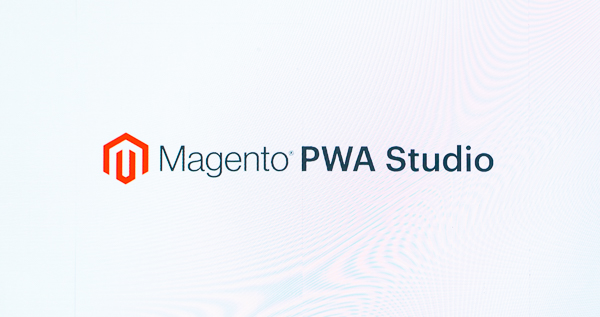
Product Release #2: Progressive Web Apps (PWA)
Woosley next introduced what I feel is going to be one of the biggest changes to website design in the coming years: Progressive Web Apps, known as PWA.
Progressive Web Apps mimic the speed and functionality of a native app on a smartphone, but don’t require the end user to download and install and app on their device.
PWA doesn’t use the traditional design layout; instead it connects to Magento using the built-in API system.
Think near instant response times, page loads in less than a second. PWA uses a new standard spearheaded by Google, and leverages a lot of caching on your mobile device.
Starbucks, BMW and Twitter have all jumped in on the PWA bandwagon.
They are seeing increases in:
- Customer Engagement
- Time on site
- Time to first interaction
- Conversion rates
All mobile browsers now support PWA; Safari announced support in iOS 11.3
Magento is releasing PWA Studio – a Magento toolkit for creating progressive Web Apps.
The first version of the tool is already available on GitHub.

Magento will be releasing Venia – a PWA reference theme for Magento 2. Just like the Luma responsive reference theme, Venia will be a great starting point for building out a fast PWA theme.
Here’s a sample category page:
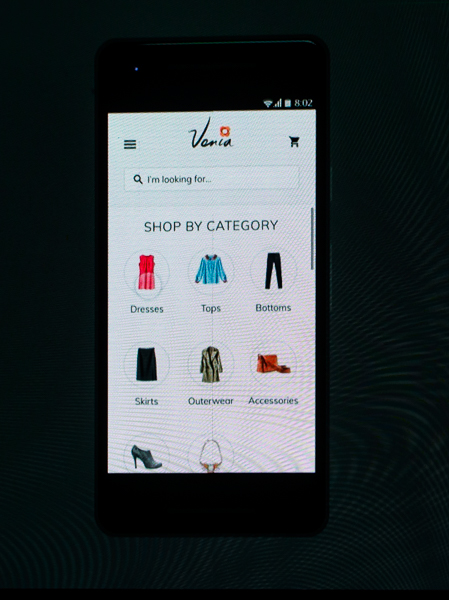
A page for search:
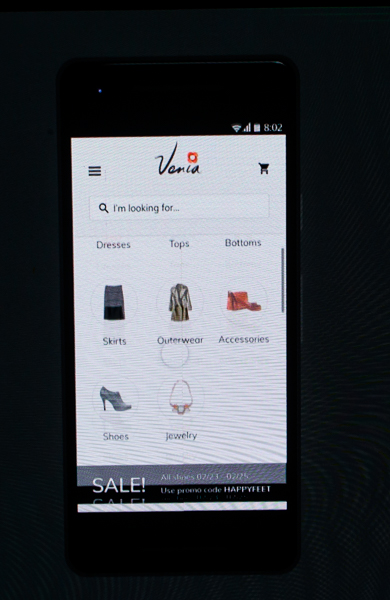
Recommendations:
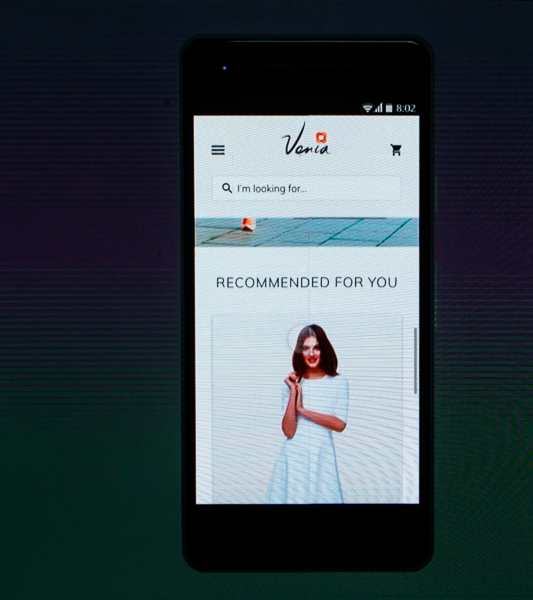
The code view for the blocks and layouts:
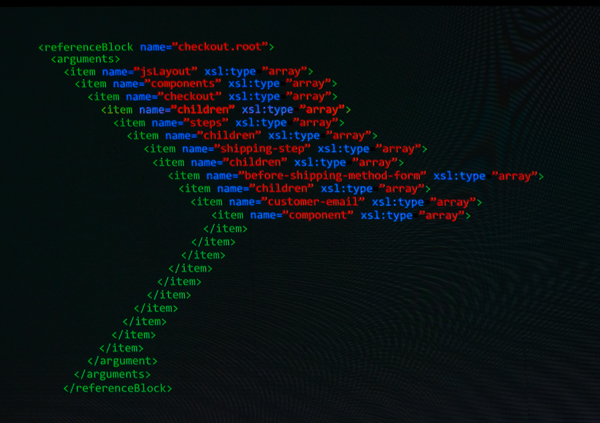
A traditional Magento 2 site, using a design like Luma has an integrated front end / back end:
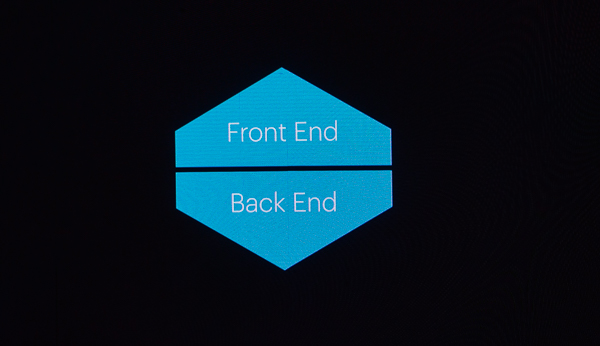
PWA uses the Magento API (Application Programming Interface) to handle the communication between the front end (customer experience) and back end (placing an order, charging a credit card, deducting inventory, etc):
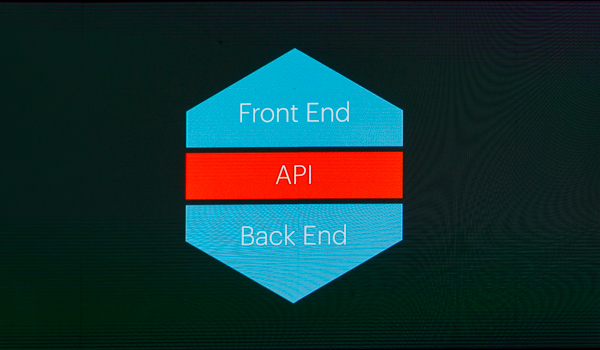
PWA is based on JavasSript:
… and this renders content very quickly:
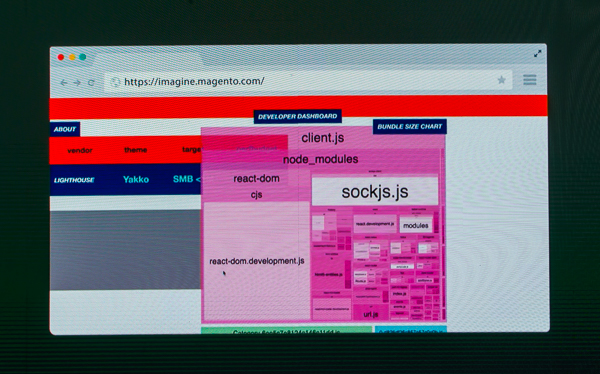
I’m not exactly 100% sure what these icons mean. But I think that if you use radioactive material in your javascript (symbolized by the atomic symbol), your site will run faster.
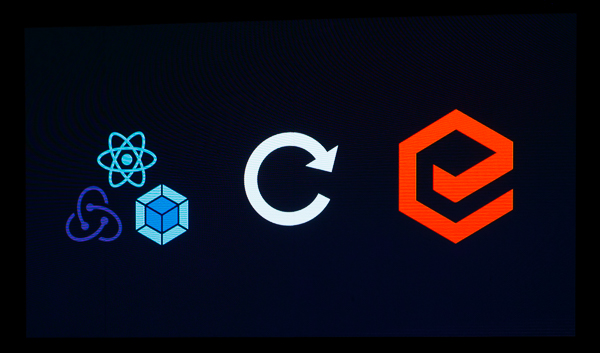
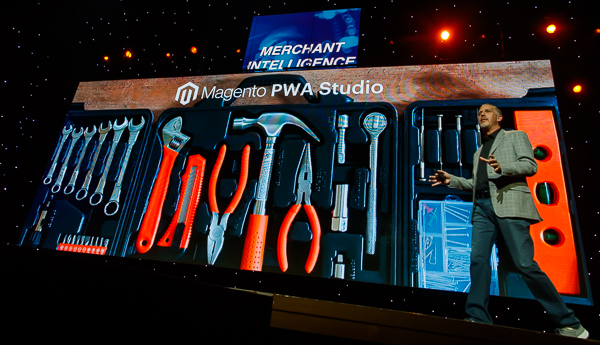
Next, Woosley featured some of the top Magento Community Contributors – people who make it their mission to create new features, write how-to articles and push the edge of what’s possible for the platform.
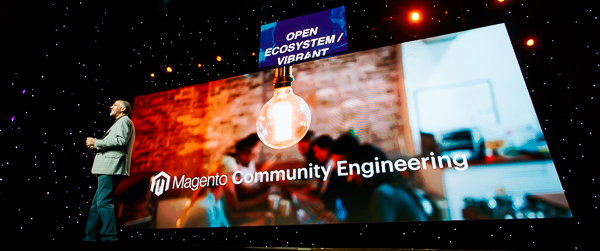
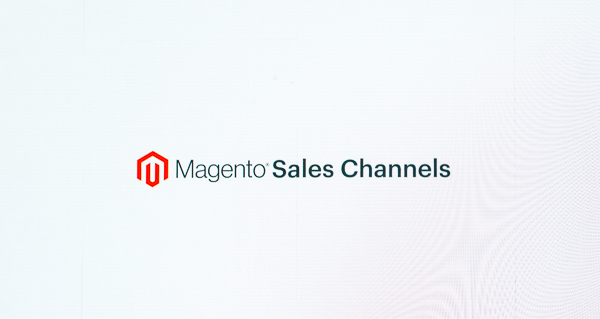
Product Release #3: Magento Sales Channels
The highlight of the Magento conference for me – Magento Sales Channels was announced.
About 60% of Magento merchants also sell on Amazon. But until now, the integration has been difficult at best.
According to Woosley, Google is losing the war for product search. More and more customers are starting at Amazon when they wish to buy products online.
Here are screenshots of the system that I captured with my camera during the video demo:
Dashboard for a Magento 2.4 site:
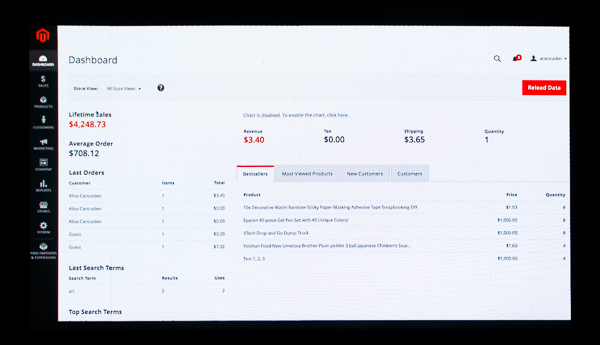
From the "Marketing" Tab…
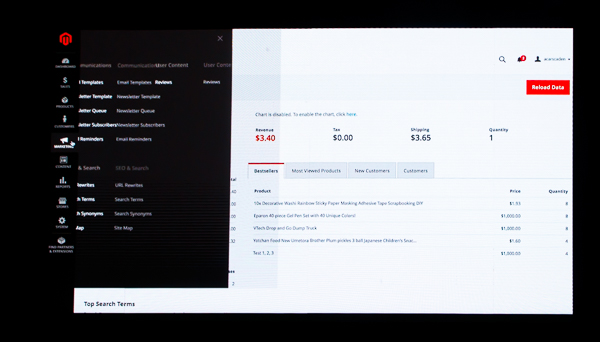
The Magento admin user selects "Sales Channels" –> Amazon
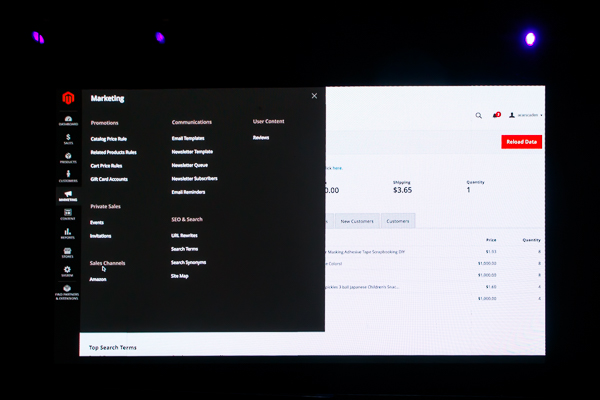
The next screen shows the different Amazon regions, including the United States, Spain, France and Germany.
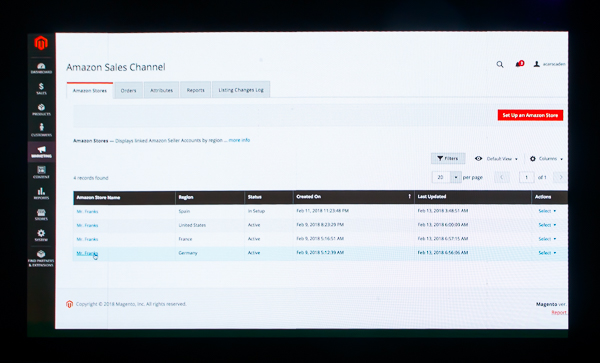
Clicking into the United States, the next screen shows Listing Rules – determining what catalog products are eligible to be listed. In this example, the Magento admin user is able to select the Main Website (and not select Canada).
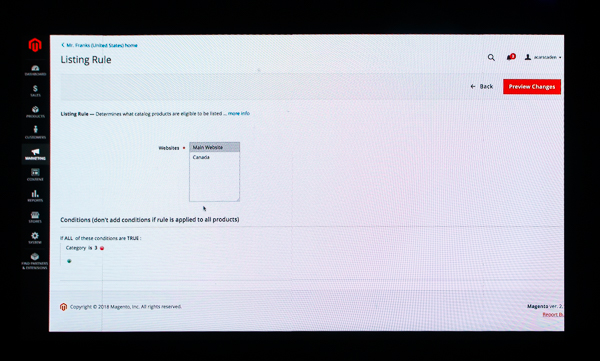
This screen also allows for listing conditions to be added. This uses a layout like the catalog price rule / shopping cart price rules. In this case, only products that belong to Category = 3 will be listed. In order to apply the listing to all products, a usr would leave this blank.
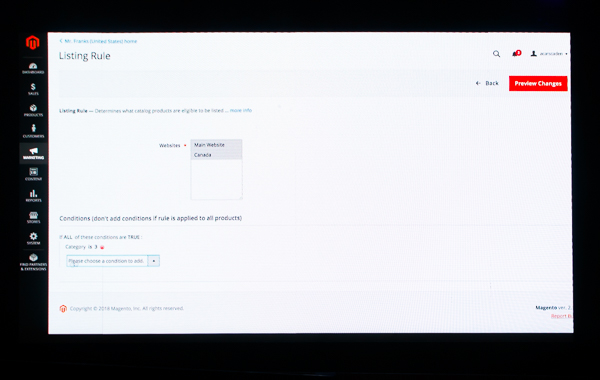
The drop down menu shows other conditions, including ASIN (Amazon ID), Amazon SKU, Brand, Category, Condition (i.e. used or new):
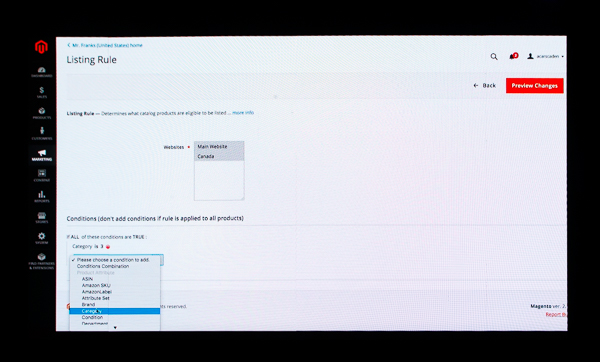
The next screen shows product listings. At the top of the page, it lists:
- Active products – 56
- Inactive products – 131
- Incomplete products – 722
- In Progress – 5095
- Third Party – 0
- Ended – 0
- Ineligible – 0
- Overrides – 1
Below is a standard grid, where it lists the Amazon SKU, Magento SKU, product listing name, condition, landed price, quantity and status.
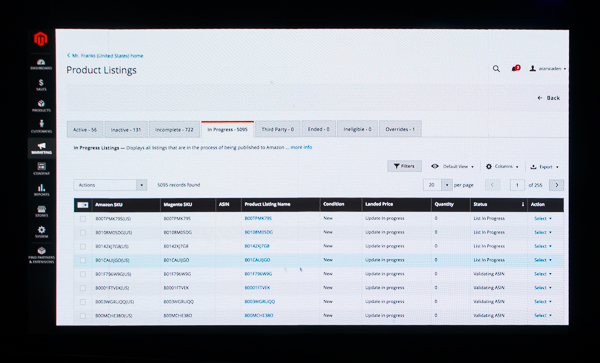
Clicking onto the Active tab, it shows all of the published active listings with the Amazon Marketplace. In this case, there are 56 records, including a meat thermometer, Xbox One and an NFL golf towel.
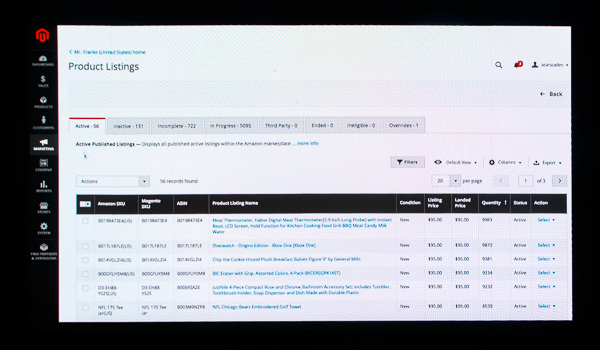
This screen shoes the Amazon SKU, Magento SKU, ASIN, Product Listing Name, Condition, Listing Price, Landed Price, Inventory and status.
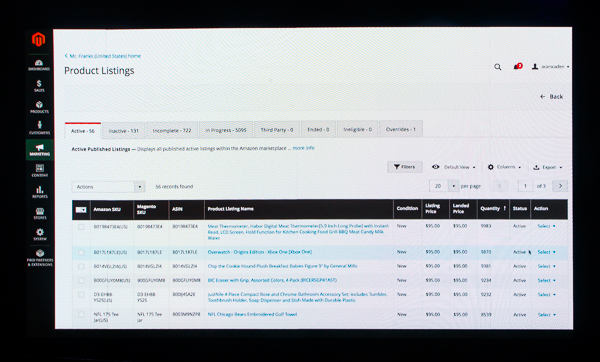
The next screen shows the Best Buy Box Competitor Pricing. According to the screenshot, it displays the merchant and price whose listing hods the Best Buy Box on Amazon. Another tab shows the lowest competitor pricing section, but that is not displayed here.
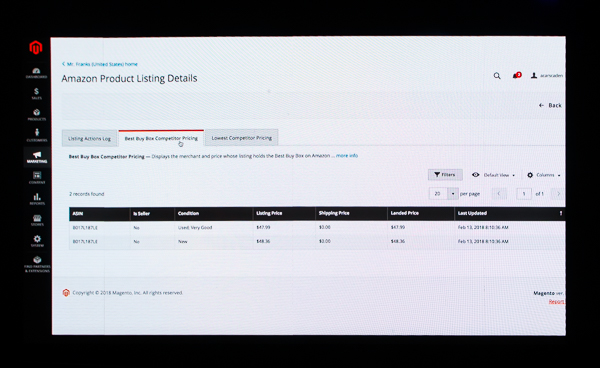
The following screenshot shows the Price Rule Settings.
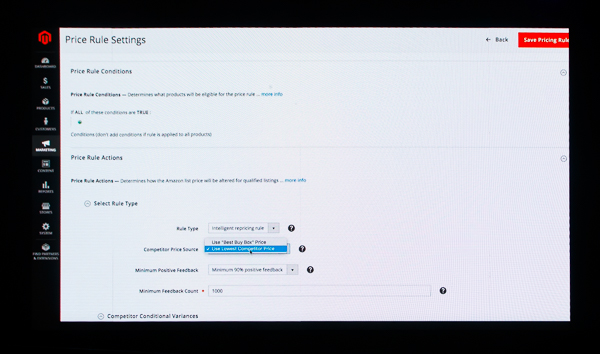
At the top, the Price Rule Conditions determines what products will be eligible for the price rule (when listing and pricing products to Amazon).
Just like the Magento Shopping Cart rule / Catalog price rule, the system uses the same conditional statements to include or exclude products. If left blank, all products are included.
I just have a screenshot to work off of, but the rule types show:
- Intelligent Repricing rule
- Competitor Price Source: Use "Best Buy Box" Price or Use Lowest Competitor Price.
- Minimum Positive Feedback
Below, there is a section for competitor conditional variances.
On the next screen, the system shows the orders that were placed on Amazon’s third party marketplace, but were brought into Magento.
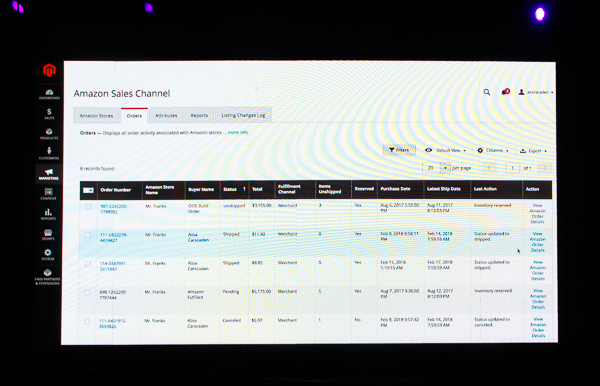
This screen lists:
- Order Number
- Amazon Store Name
- Buyer Name
- Status (Shipped, Unshipped, Pending, Cancelled)
- Order Total
- Fulfillment channel (Merchant, Amazon)
- Items unshipped
- Reserved (i.e. the system will take inventory from the Magento store to reserve inventory)
- Purchase Date
- Latest Ship Date (so you’re not late shipping the order)
- Last action
- Ability to view the Amazon Order details
On the next screen, the Amazon Order Details are displayed:
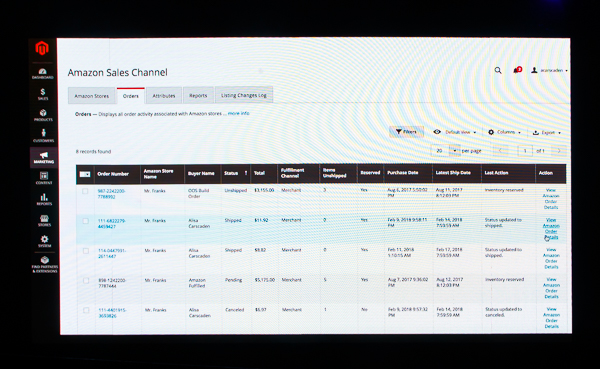
… including the anonymized email address for the buyer. (If you sell through the Amazon marketplace, you have to contact the buyer through an email address that is tracked and relayed through Amazon.)
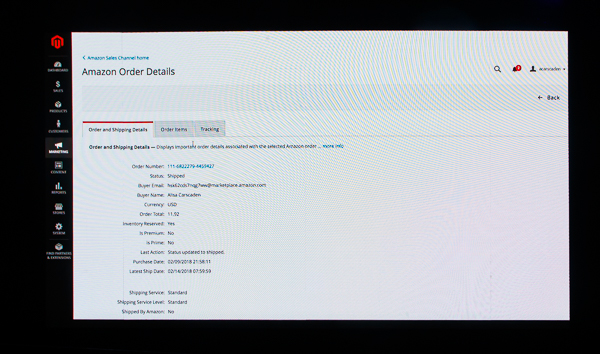
The next screen shows the Amazon order items – the actual products that the customer ordered:
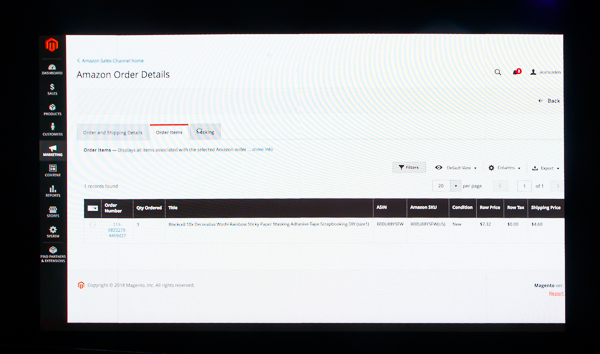
The Create / Edit Attribute section allows the Magento admin user to create new attributes in Magento to match up with the Amazon product information. In this case, Amazon Label is the attribute that will be imported into the catalog, when the product is imported from Amazon to Magento.
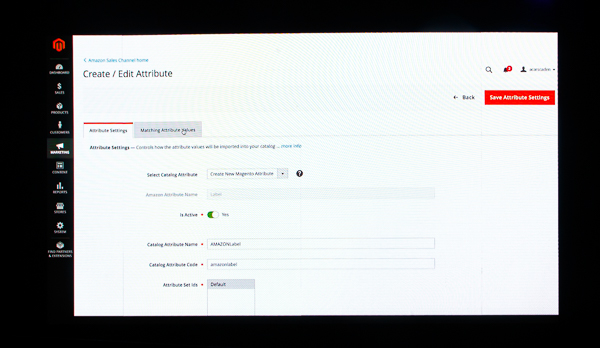
On the next screen, you can see the matching attribute values – the values from Amazon for the selected attribute:
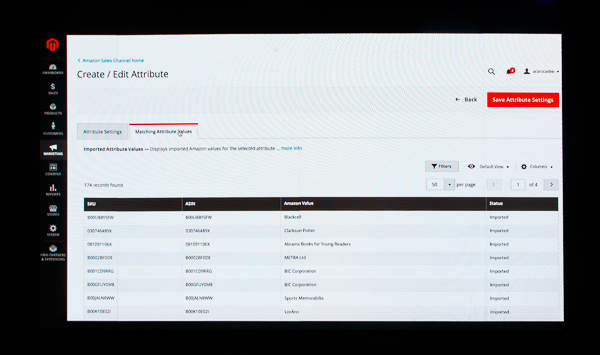
This is a product page on Magento, with what looks like the default Luma theme:
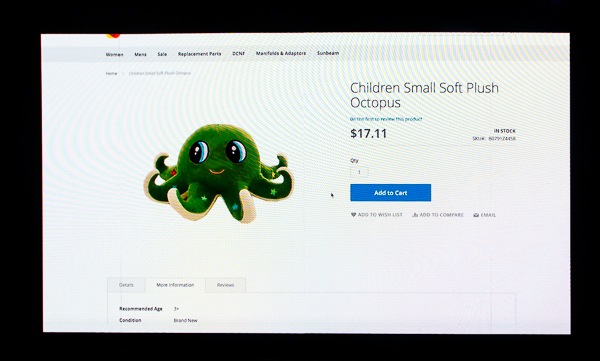
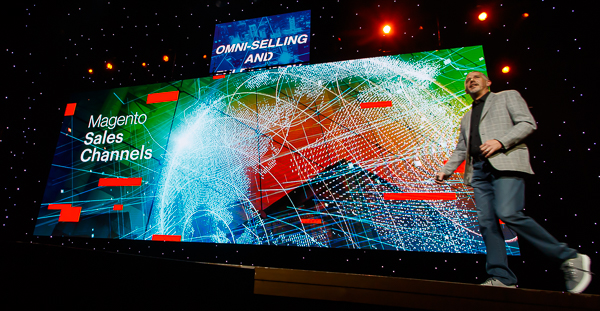
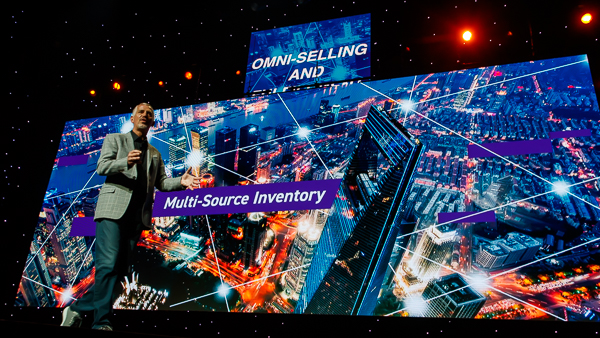
Product Release #4: Multi Source Inventory
Woosley briefly discussed a community collaboration project to bring multi-source inventory to Magento.
When the Magento system was first created many years ago, it was created with a design framework that a company would add in products by hand to the admin, customers would purchase items, and the company would then ship those items from the back of their warehouse.
Back in those days, there was never a concept that inventory could live in multiple locations. For example, Product XYZ might be stored in a warehouse in New York, as well as in California. Wouldn’t it be great if Magento could figure out which warehouse to ship from, based on the destination? Or, Product ABC is only stored in a California warehouse. It can get complicated quickly….
Inventory in Magento is mostly treated as an integer. For example, you have 150 units of Product XYZ. If someone purchases 25 units, the Magento system knows it has 125 units left in stock. But Magento doesn’t have a concept of LIFO or FIFO, or historical inventory flow.
I haven’t yet seen the multi-source inventory system in detail, but this will be a great addition to the platform.
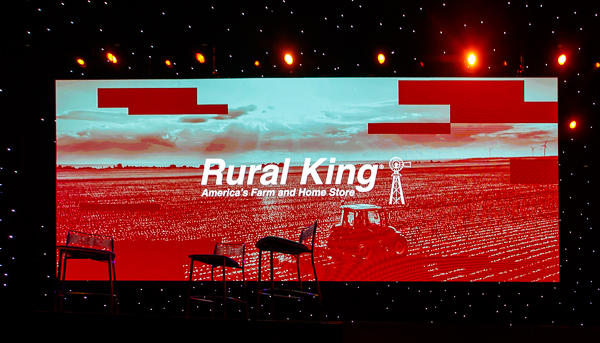
Finally, to round out the show, Rural King’s CEO joined Magento CEO Mark Lavelle and SVP Jason Woosley to discuss how they use Magento, and how they’ve been successful in the space.
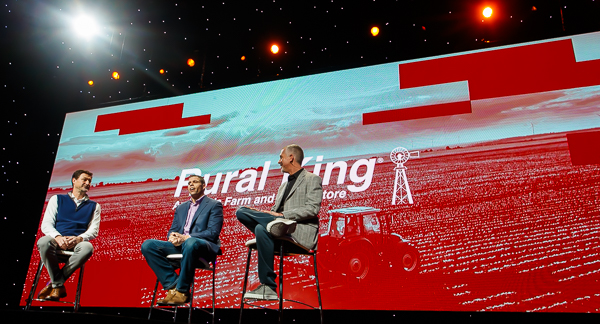
Part of what keeps Rural King successful is that they are true to their roots.
Their CEO proudly wears jeans and boots… here’s a close up shot:

And with that, Imagine 2018 came to a close. Phillip Jackson gave us the dates for next year – May 13-15, 2019, at the Wynn in Las Vegas. See you there!
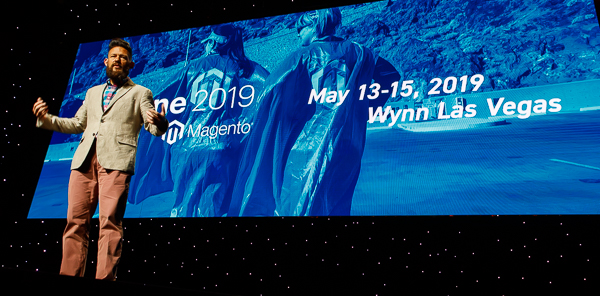
Until next time,

Jeff Finkelstein
Founder, Customer Paradigm
303.473.4400
We love referrals! Our Referral Promise >>
|